What’s It Worth?
A few weeks ago I posted a blog on the pieces I had made over the last two years. So other woodworkers, you know, the professional ones, the ones who say you cannot make a living working with your hands using hand tools and just a bandsaw, could see what can be done if you apply yourself to master hand tools. I thought it would help if I priced what I would sell the pieces I made for the Sellers’ Home series for but not as a famed woodworker. I based the prices on what I sold my work for when I lived in and around my last years living in Texas which ended in 2009.
Remember that every one of these pieces made for the house is a new and unique design from my Sellers’ Home Portfolio Collection. I have not added any design costs as I might if I were making to sell a unique design of my own to a customer so that would increase the pricing. I have always clarified to my customers that if I design a unique piece for them, a piece never designed or made before, then there is a design cost simply because a new and unique design takes as much time as making the piece. The design, intellectual property and copyright always remain mine as the designer-maker alone and are never transferred with the piece unless determined ahead of time.
January 2021
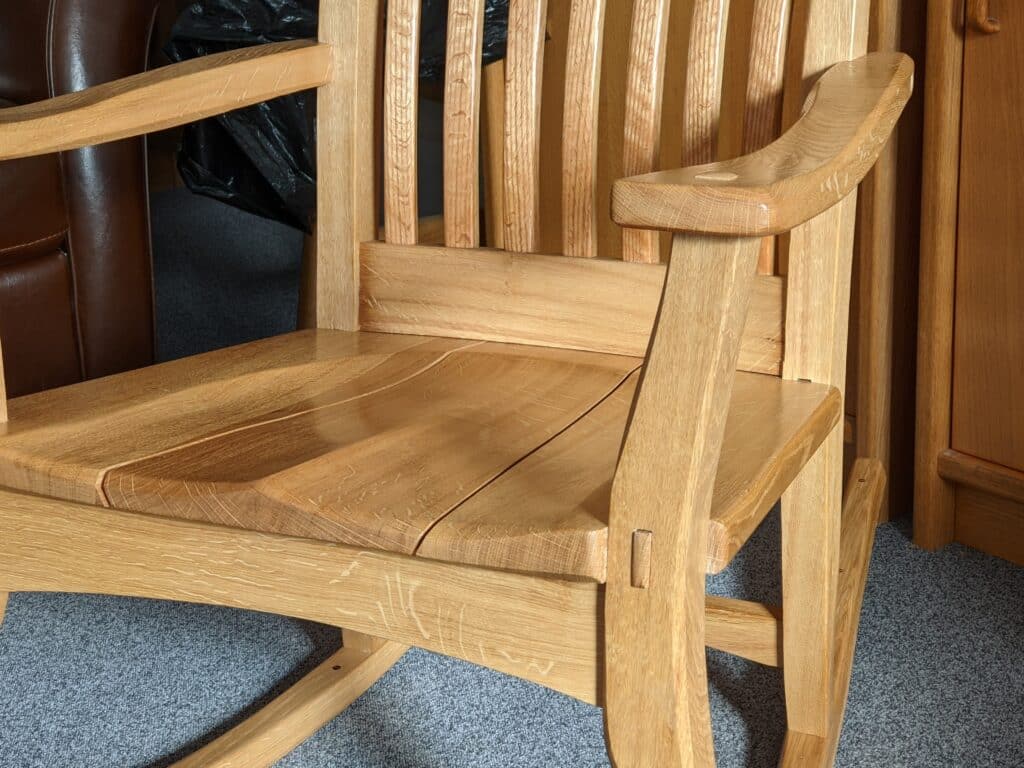
The first piece I made was the cherry rocking chair. I can make this in five to six days ten-hour days so let’s say six days. I would sell this chair for $3,600 and it would sell easily for that. The Brazos rocking chair I designed and made in Texas for a decade sold over and over for $4,000.
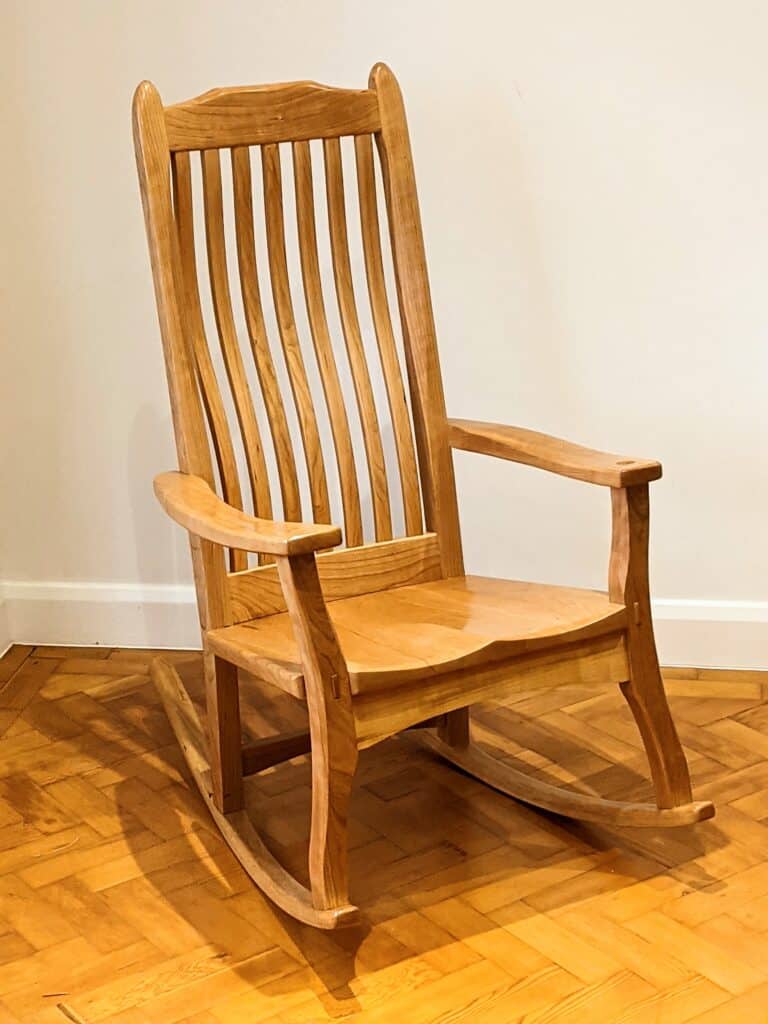
The coffee table would sell for about $2,000. Probably more, $2,500. This was a week’s work. Why am I working in dollars? Because the USA was where I lived and worked and sold my work in the more recent decades so why not?
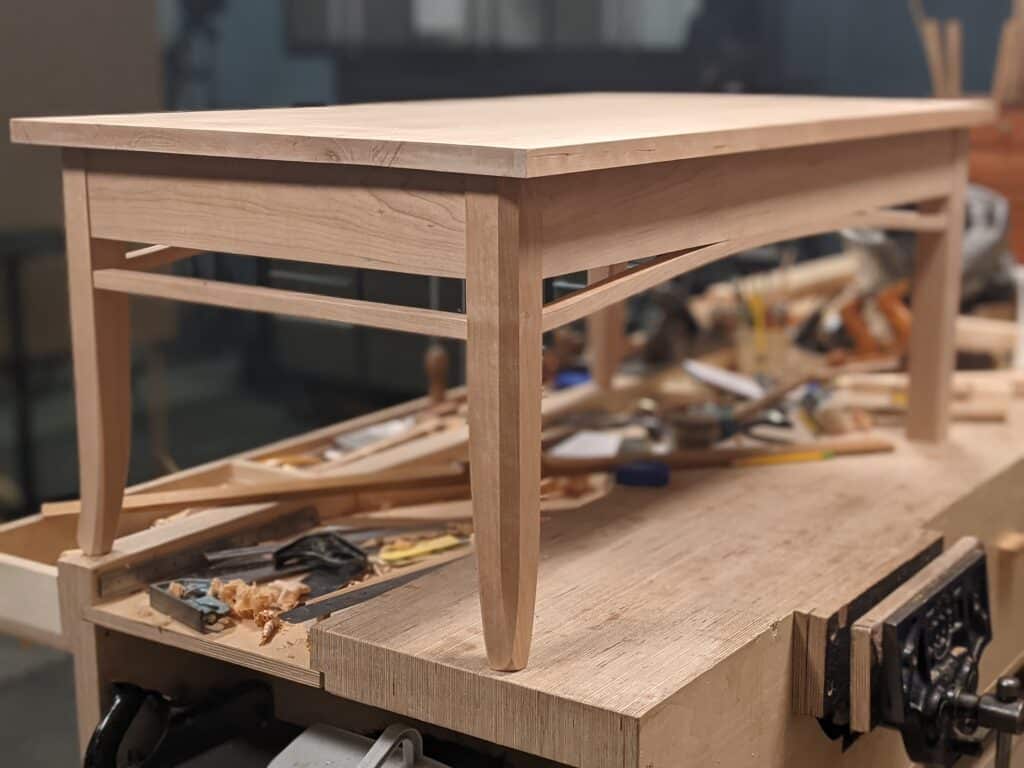
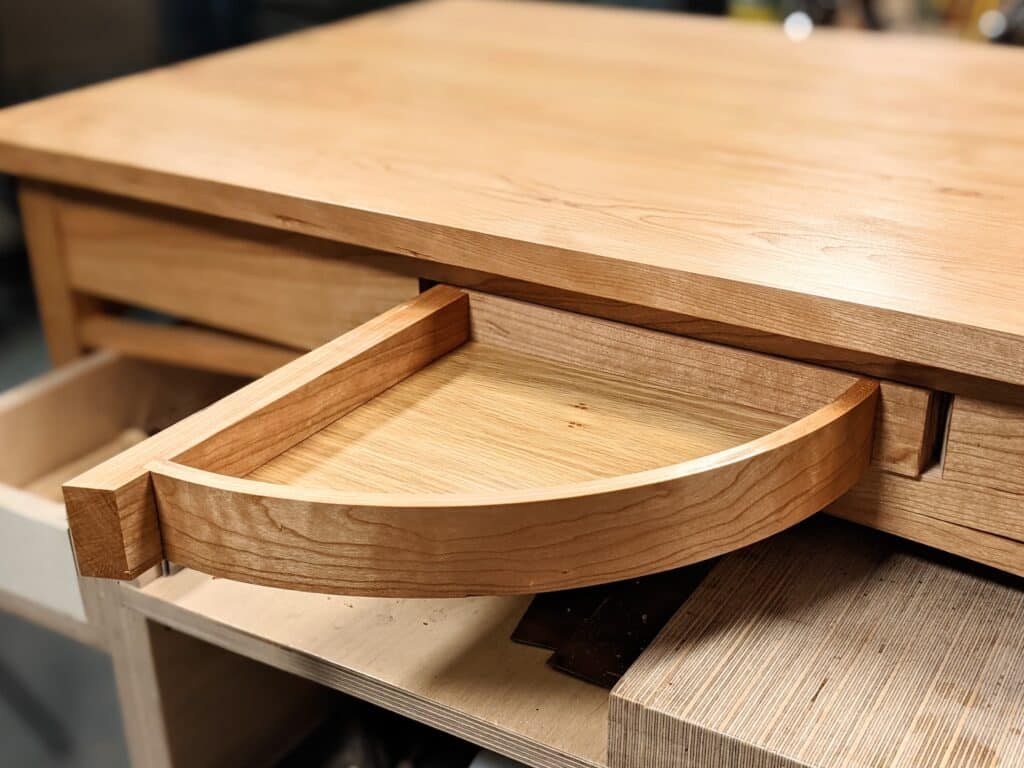
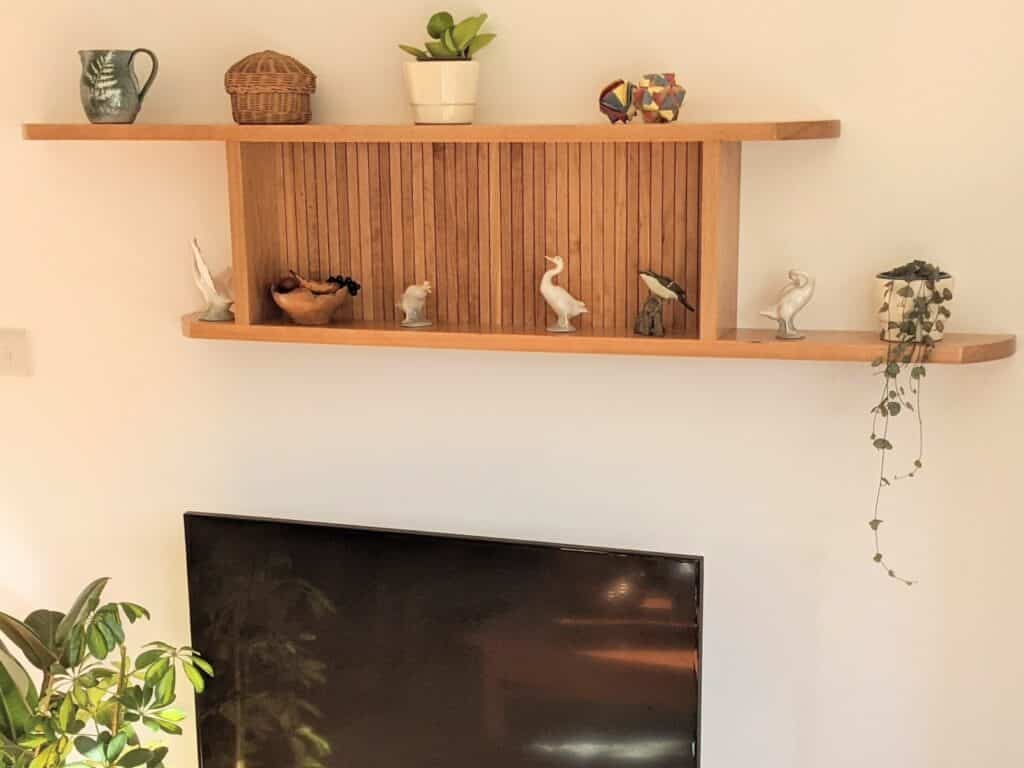
The wall shelf I would sell for $500. I could sell a larger, deeper version for more, perhaps double that, even though it would not take twice as long to make. This was a day’s work.
The bookshelf will sell for $1,200 though I would most likely simplify some of the construction by not having through-tenons and using a cherry plywood panel for the back rather than the bracing. This was a week’s work and some of the features were added to make the project more of a challenge for those following and learning. The through tenon idea added a lot of substantive strength and resilience to the piece.

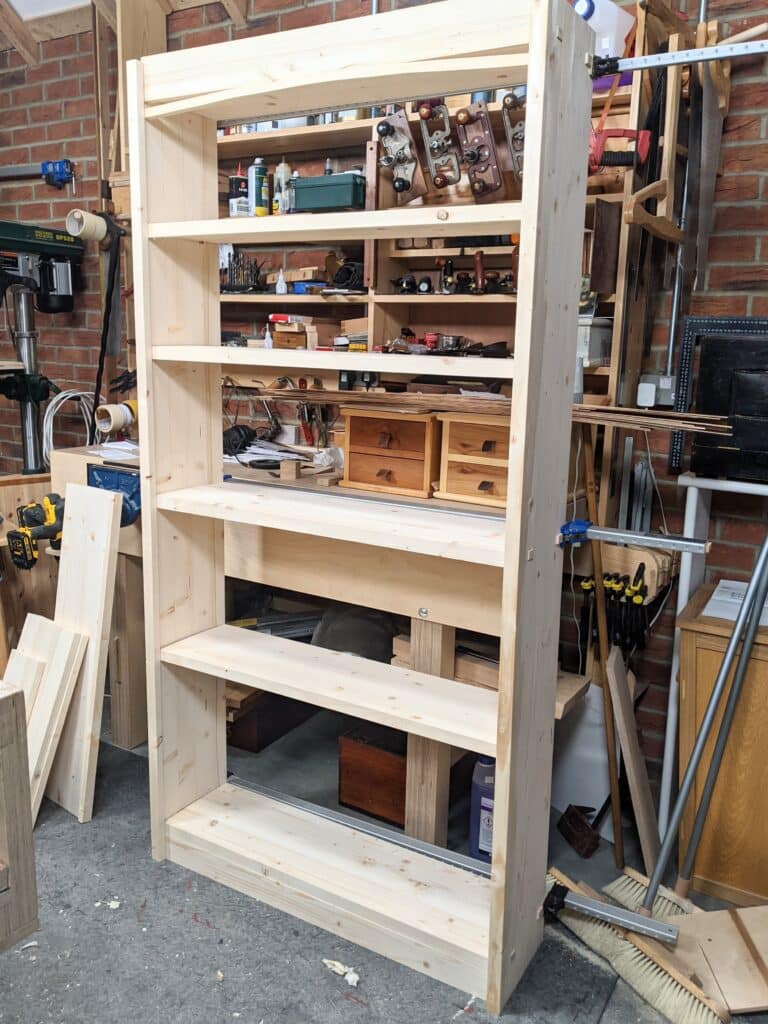
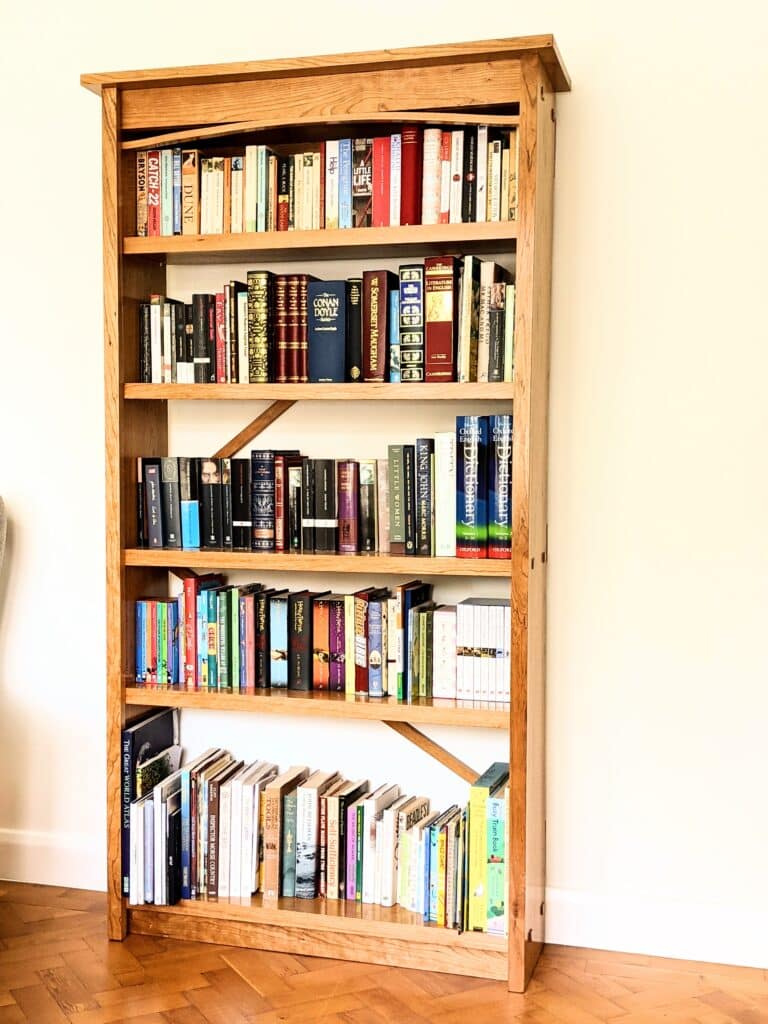
Sub total so far is $7,800 for about 18 days labour. So, $433 a day less materials.
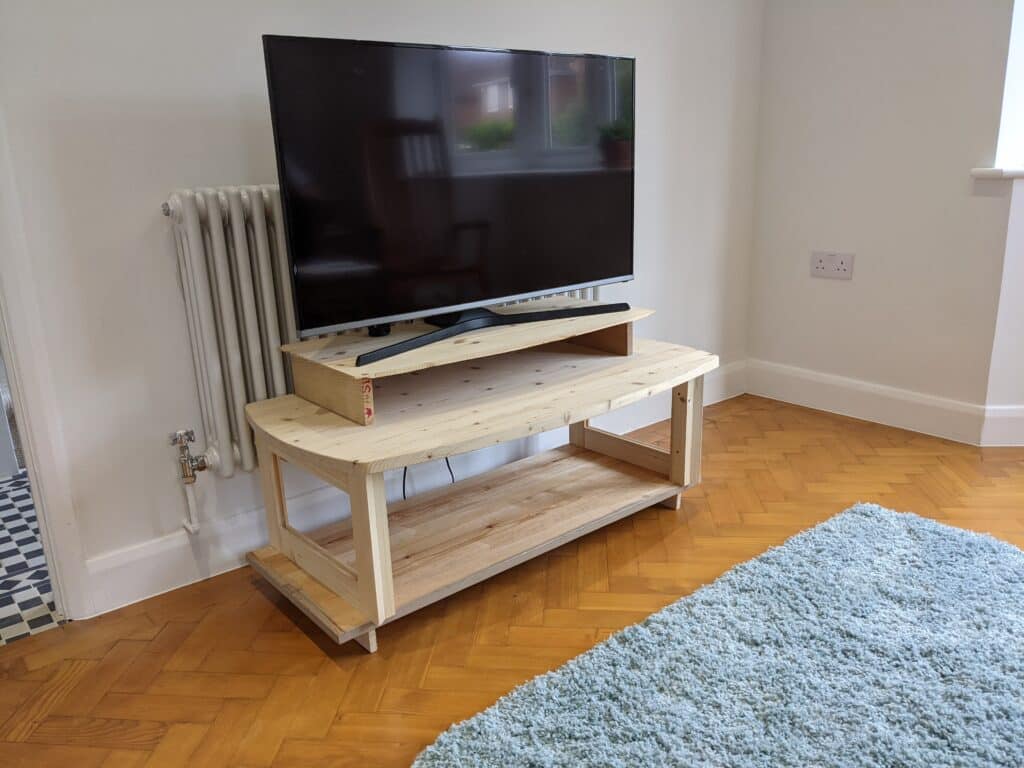
The TV stand was quite intensive and I’d allow 10 days for this one. The design and functionality combine as practical solutions for a place for the flatscreen and storage for things like toys and blankets, less used things too. I am going to say $2,000 for this so we drop in our daily rate here. I could be wrong.
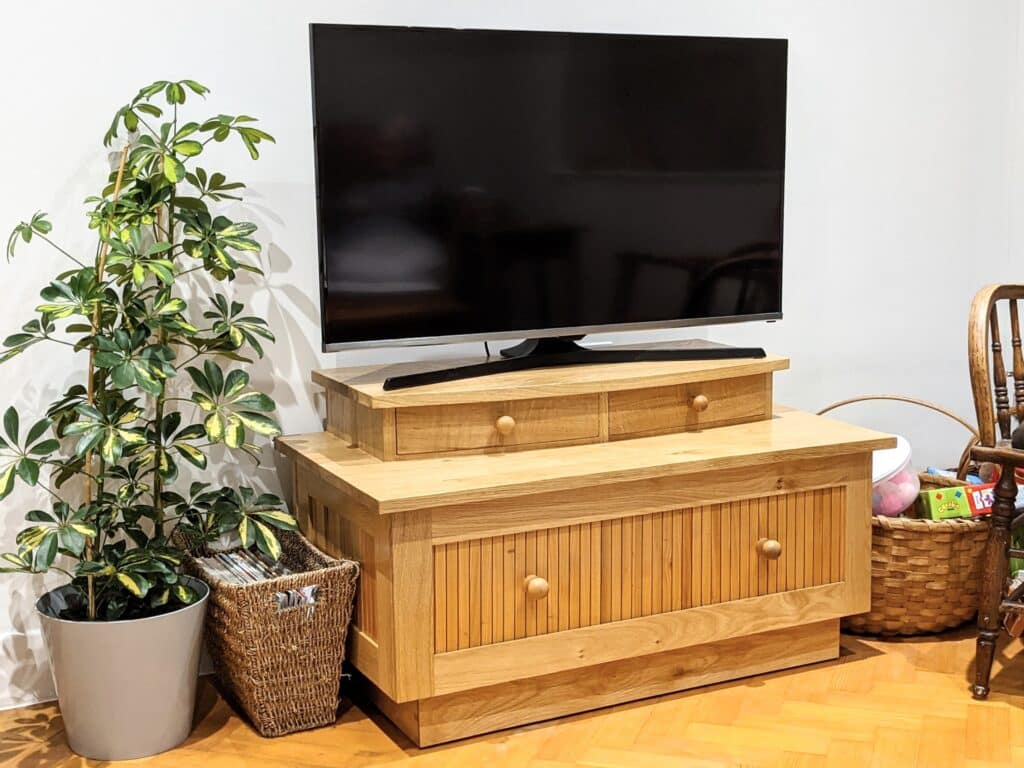
Small, occasional tables can take as long as larger ones and here is somewhere you might lose out if you just make one. I would always gang this up and make a small batch for this and other rooms. That’s mostly if I was selling my work or if I wanted to maximise my efficiency time-wise. In other words, it might take me two days to make one small table but more likely three in just over two days. Currently, I have six in the house. They are square, round and elliptical but the work is the same with only minor adjustments needed to accommodate the shape of the tops. I have three in the living room. Making a batch would likely average out at around six hours apiece. I would sell these for $400 apiece. They are well worth this. I’ll say three days just to be sure. I used these to show different construction elements including the geometry for laying out the cut lines to follow. There are many ways to lay out ellipses be they two nails in a trammel or a piece of string limiting both axes. Tables like this are especially useful. From chairside to bedside to outside on the patio.
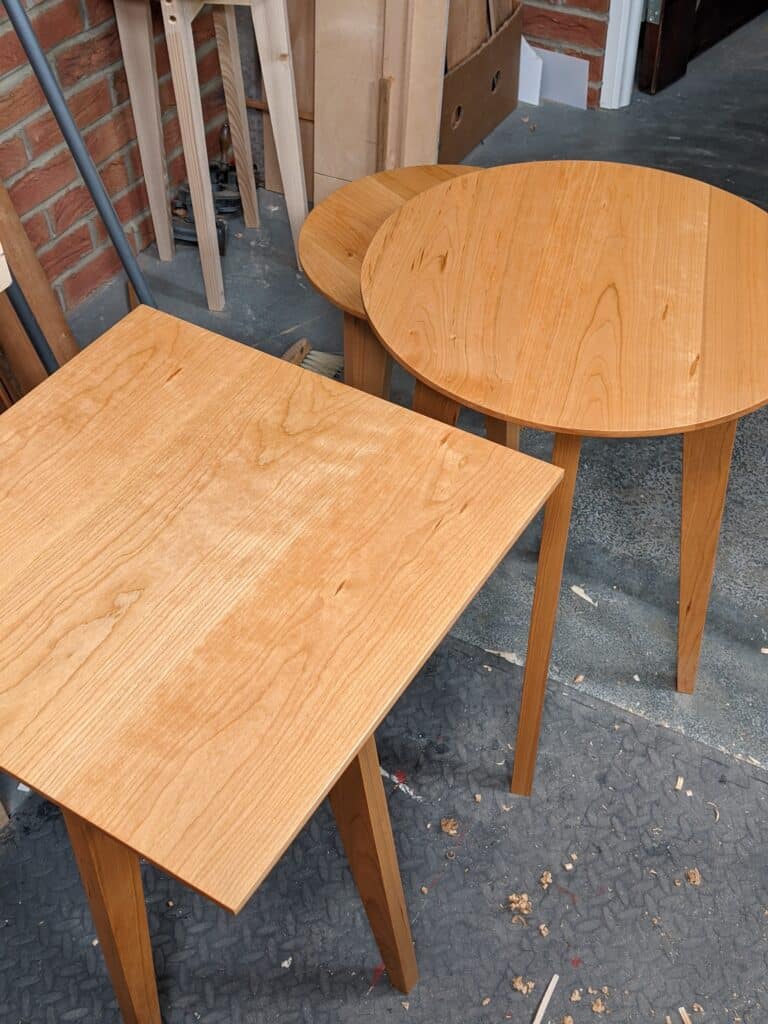
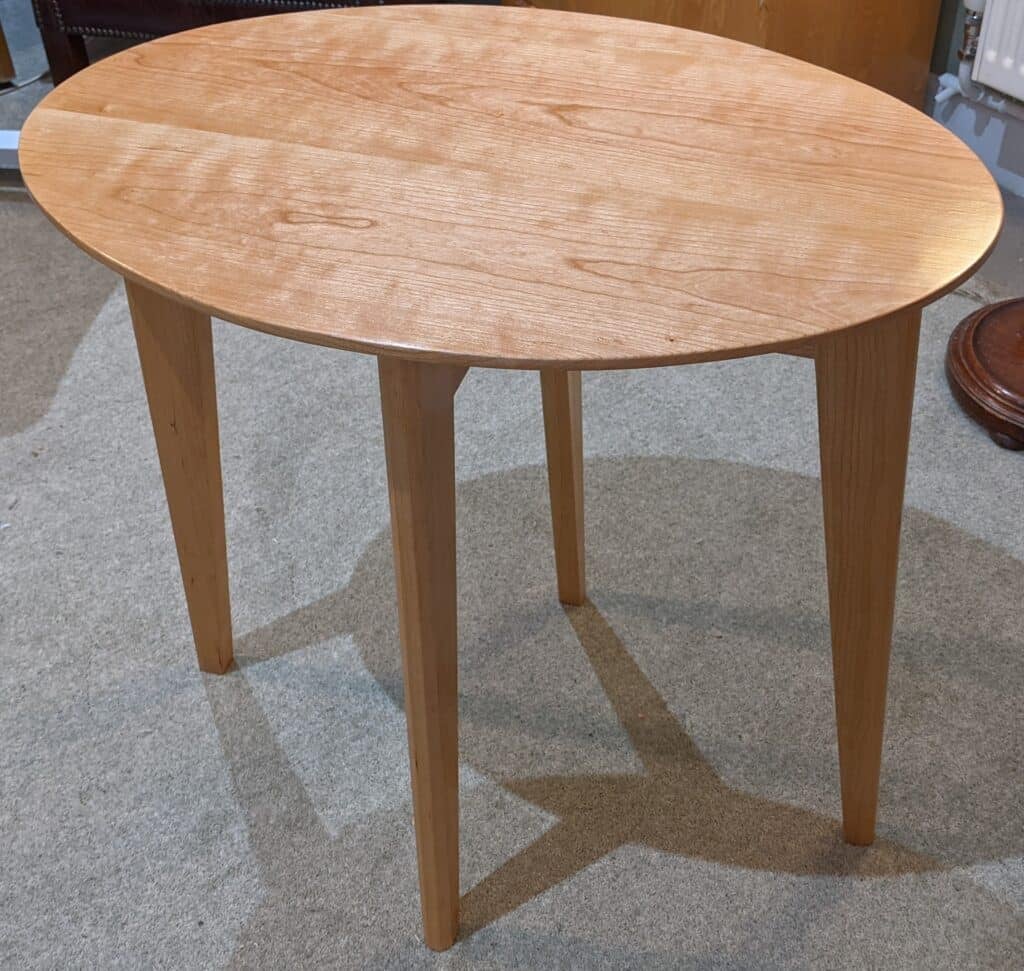
Of course, It may have taken me 11 months to have everything in place but the actual time spent in building is the more important factor because, of course, my day involves many other things like designing router planes, spending time teaching my granddaughter to use hand tools and such that also came in 2021. I actually made four of the rocking chairs and then prototypes of the other pieces. The prototyping is less necessary in the ordinary days of my making but I do it to help us in the video side of things. It perhaps sometimes caters to the impossible shots that might otherwise move too fast for them to get focussed on an aspect that’s needed.
So, we have 31 days to make $11,000 so far so we are looking at $354 a day minus material costs. Now as a full-time maker, I had zero device tolerance. Mostly because they didn’t exist in my world. Watching modern makers fresh from college in an environment where the makers rented space I was shocked at how much time was spent staring at screens and tapping keys and how little time was spent at the bench with wood in the vise. I recall about 75% on screens and 25% making. A total imbalance propagated by educators gave these makers the impression that part-time was a deserved right and that they would be able to make it with this false impression. You could if the work on the computer was establishing some other element to be involved in the making. Perhaps an employee maker, CNC equipment, premade or bought-in components like fastenings, pocket hole stuff for hiding screws, etc.
January 2022
The dining room table is an easy make but I added awkward things to increase strength and rigidity as a design element and something I wanted. A dining table, even though perhaps less work than the coffee table, will command a higher price. $3,000 is a payable amount for a good design in an eight-seater dining table in oak or any hardwood. Usually, I would allow three days for the frame joinery and then a day for the tabletop glue-up, cutting to size and clean-up. Scrape and clean up ready for finishing the whole and then a three-coat finish would usually take a day. The table was delivered January 22nd 2022.
As an afterthought, remember that it will take almost the same time to make a four-seater dining table as a six or an eight-seater. The joinery usually remains the same so most of the extra work is in the tabletop alone. You can save a lot of time and energy by buying your wood planed foursquare so all you have left to do is glue up and light scraping.
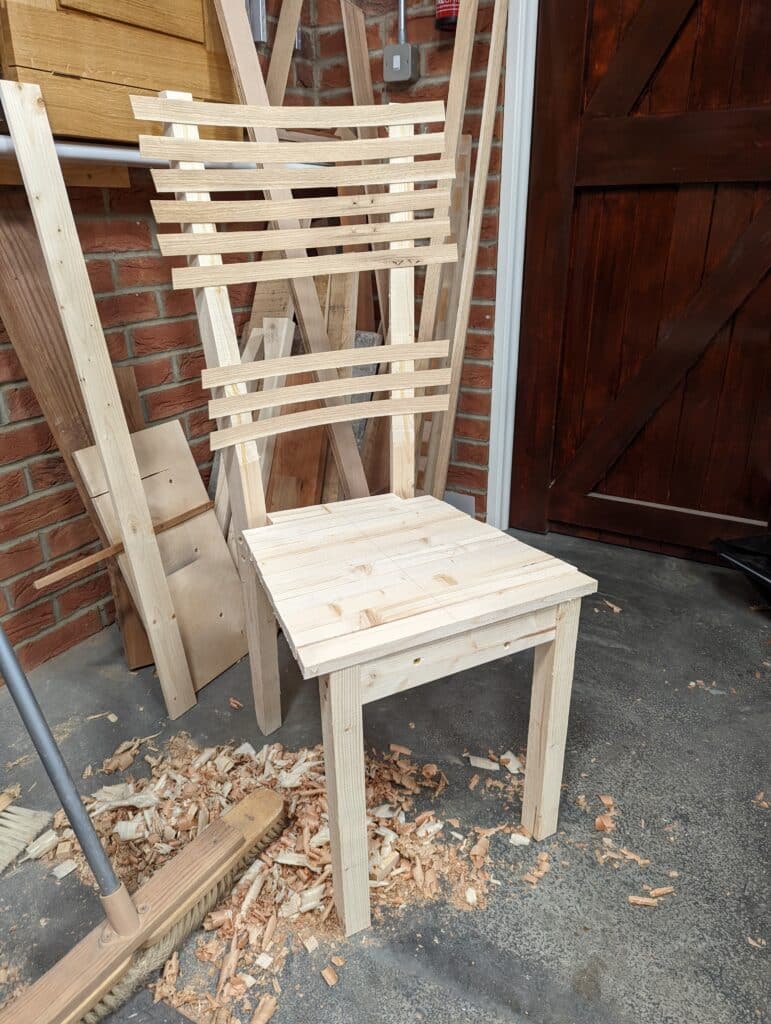
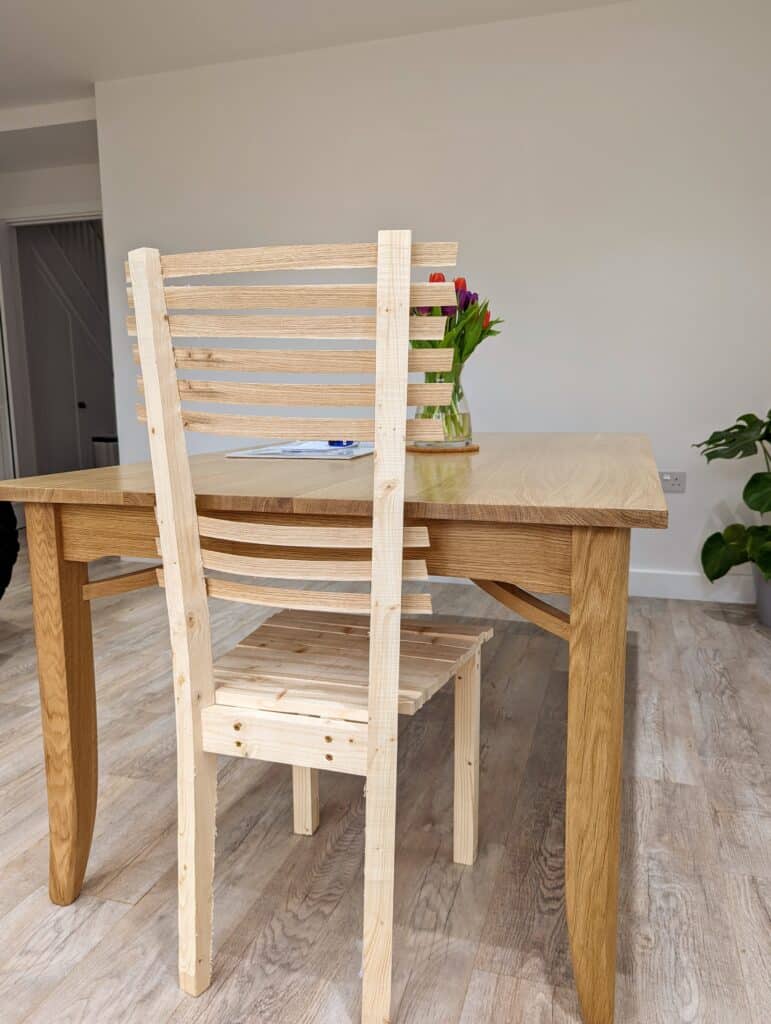
Chairs are something else. Making one is time-consuming and designing a new one all the more. This design came together after three prototypes were abandoned. I changed my mind for different reasons and finally ended up with something I liked. Each one is a three-day project but batch production makes things more structured and organised so I calculate two days per chair. I ended up making nine chairs altogether plus my abandoned versions. I always sold dining chairs in Texas for $1,500. They are time-consuming and for a unique and distinctive design, $1,500 is not too much to ask. So, in a five-day week that’s two and a half chairs. $3,750.
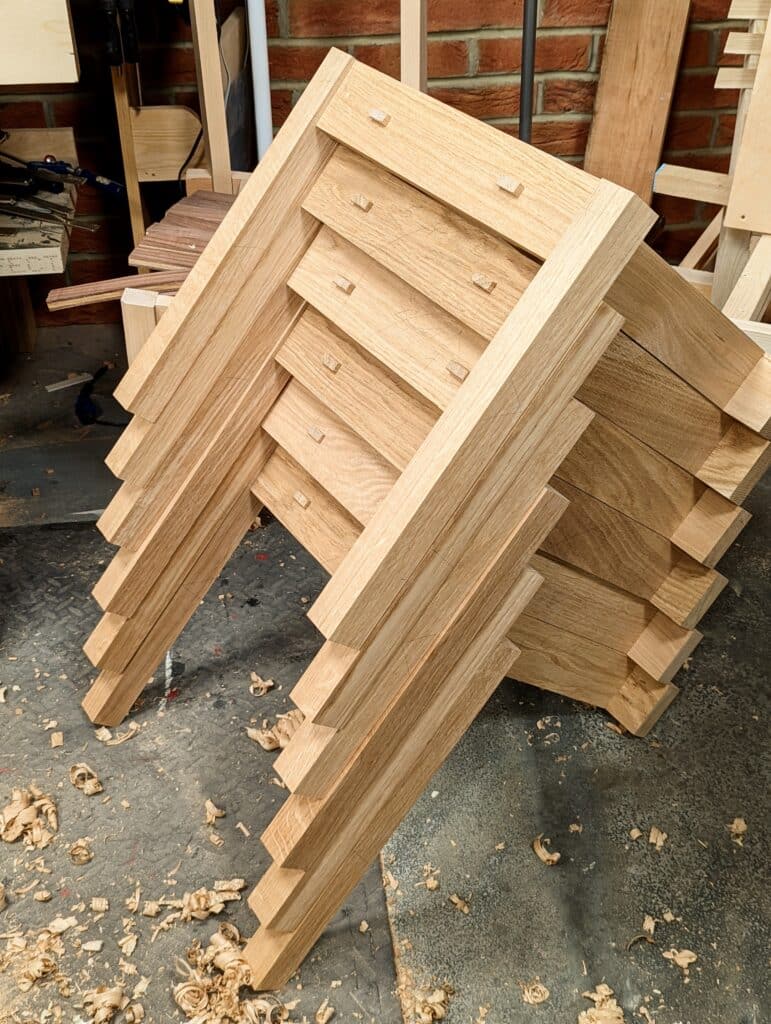
In the end, I felt pleased about my performance in making. The satisfaction of radical design is immeasurable. Until the chairs are round the table the table looks lost and meaningless as does the whole dining room. when the chairs go in it all comes together.
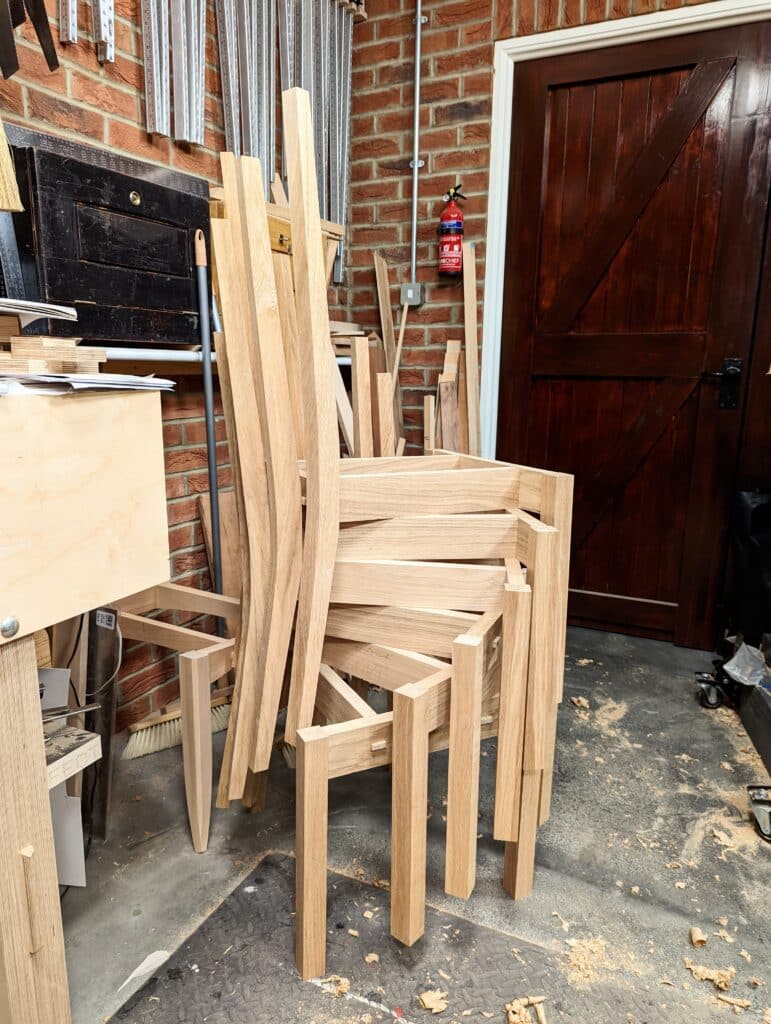
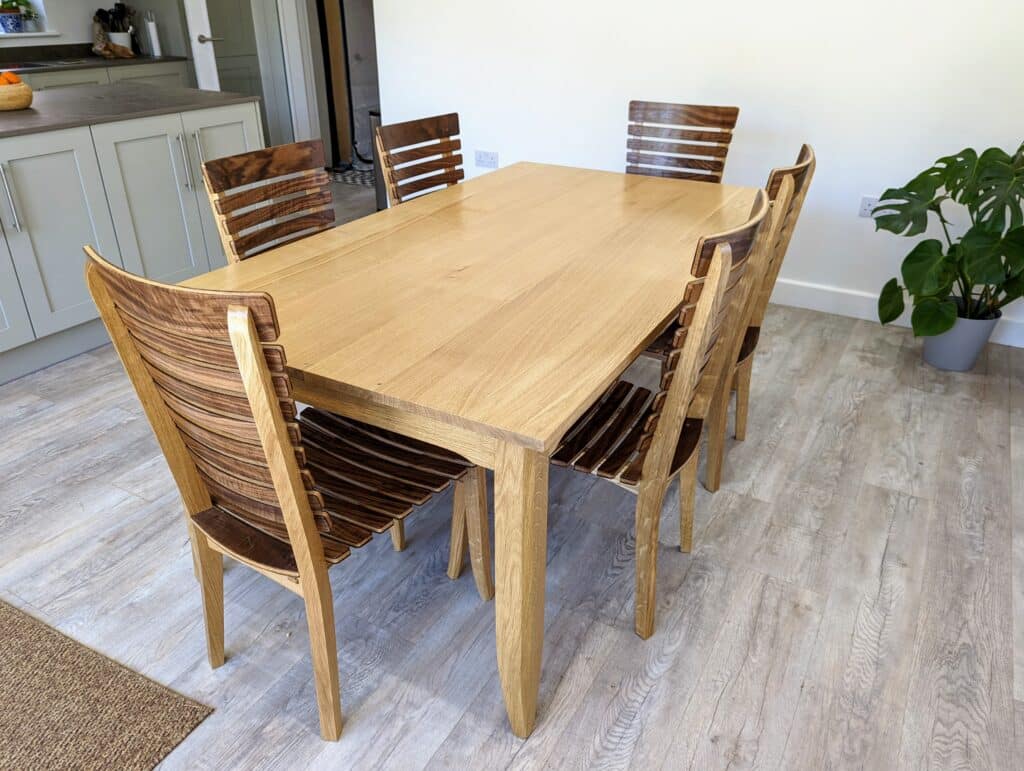
Now I hasten to add here that you can do this too and you can do it with the self-same tools and equipment I did which is mostly, mostly, almost all, with about ten hand tools plus a few others that are not so much essential but convenient. The only machine I used for these pieces in the house so far was a 16″ bandsaw to resaw through significantly wide stock. That won’t change for me. You can also consider getting your wood pre-planed or even milled to size without recrimination for me if you want to. I see nothing wrong with that and there can be a dozen good reasons for doing so too.
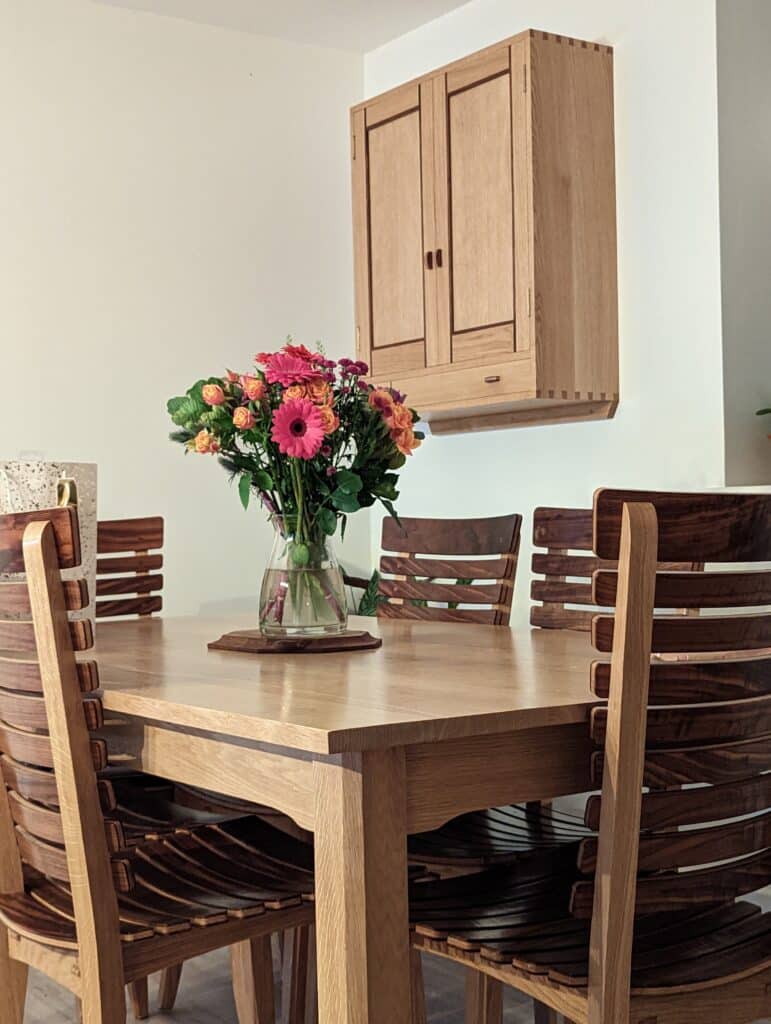
Two other more complex pieces fleshed out the dining kitchen area. The wall cupboard (above) and the two sideboards. The wall cupboard came as two units in oak. I made the original prototype in oak simply because it was so much work I thought I would like one in my garage workspace to keep my 20 years’ worth of journals safely together.
This section of making cabinets is more my cabinet-making course in that it is forming the main cabinets with door- and drawer-making included. For the wall-hung piece, I chose oak for its traditional use in furniture making and as a wood that lives worldwide on all of the continents. It’s a pleasing wood to work with, planes silky smooth and scrapes well too if there is awkward grain. These types of cabinets are time-consuming to make. The wall-hung version is a good two weeks of hand tool woodworking, two days for the carcass, three days for door making and fitting and two days for drawer making and fitting. Cleaning up the wood beforehand is about two days and applying finish a day or so. The handles are pernickety but enhance the design. But ten days at $400 makes it prohibitively high, I think. I believe $2,500 to be reasonable though. A different wood with contrast and figuring would raise the price up to an additional $500-$1000 perhaps.
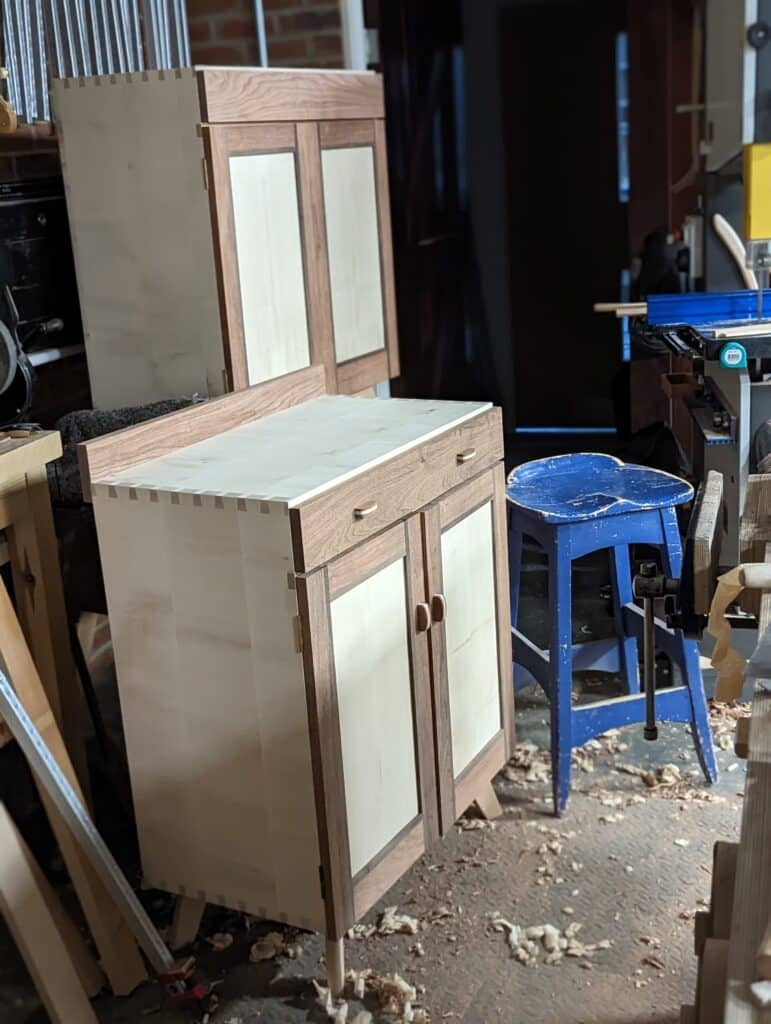
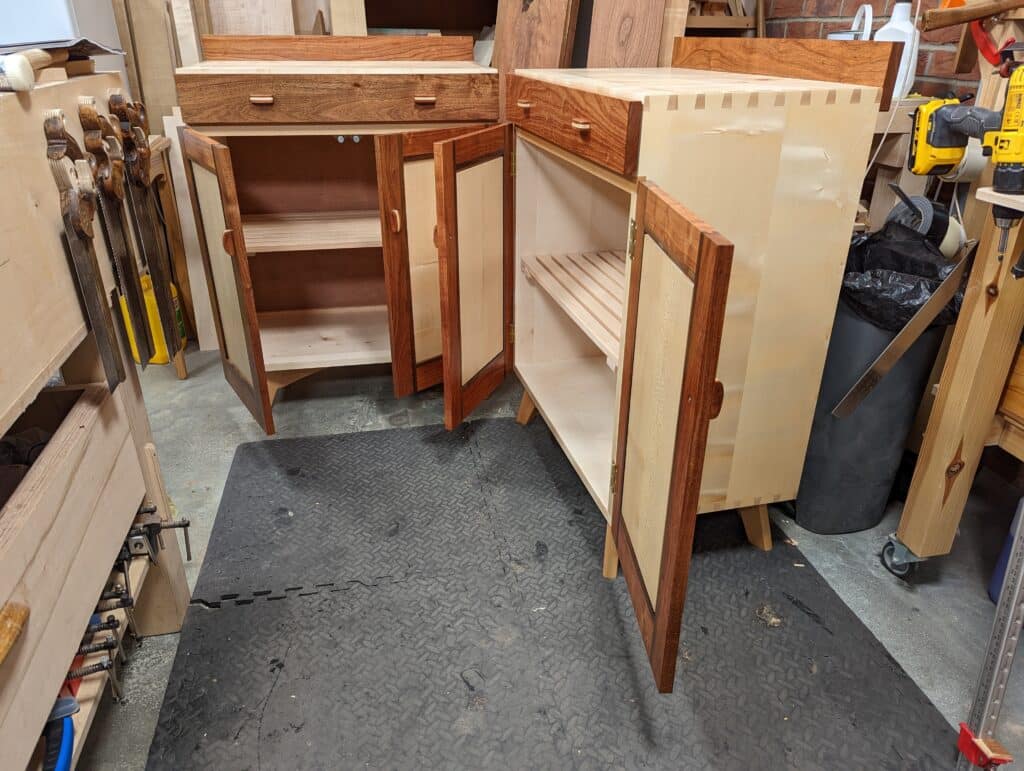
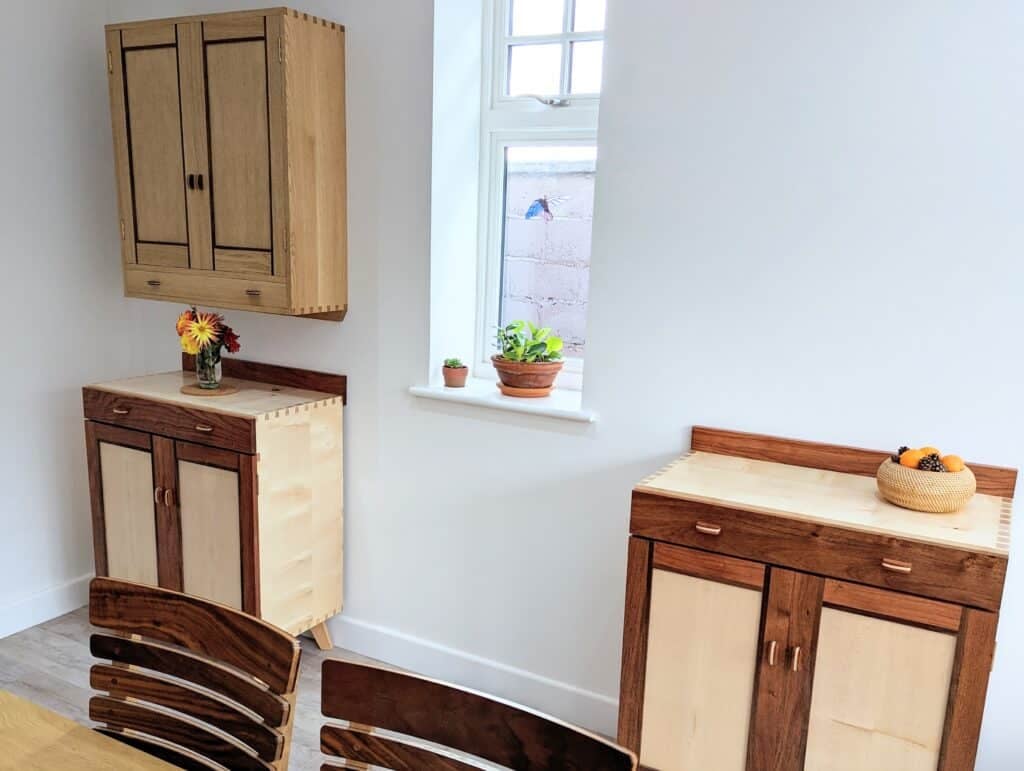
So the base unit really enhanced the overall look of the dining area. The choices of wood increase the value and improve the appearance but they would look very nice in the same oak as the other pieces. I wanted a stunning contrast and went for white with dark red. It worked for me.
I made a prototype in the same wood so that the whole could be trialled and tested for a variety of reasons. Neither of the two key woods used are at all standard. Mesquite with sycamore will be extremely rare if ever put together in this way. I am fortunate to have both in stock from years of acquisition. I want to use the mesquite up. It’s an amazing wood. The instability of sycamore and the amazing stability of mesquite somehow did it for me.
The cabinet would go anywhere in a house. I took two weeks for the second one and three for the first. Five weeks in all. I would sell these to a customer as a non-famous person for $3,000 each. To the right customer, they would sell easily enough. They cannot be compared to any other work making them highly distinctive and a focal point in a room, something people usually like in the same way artwork does. $6,000
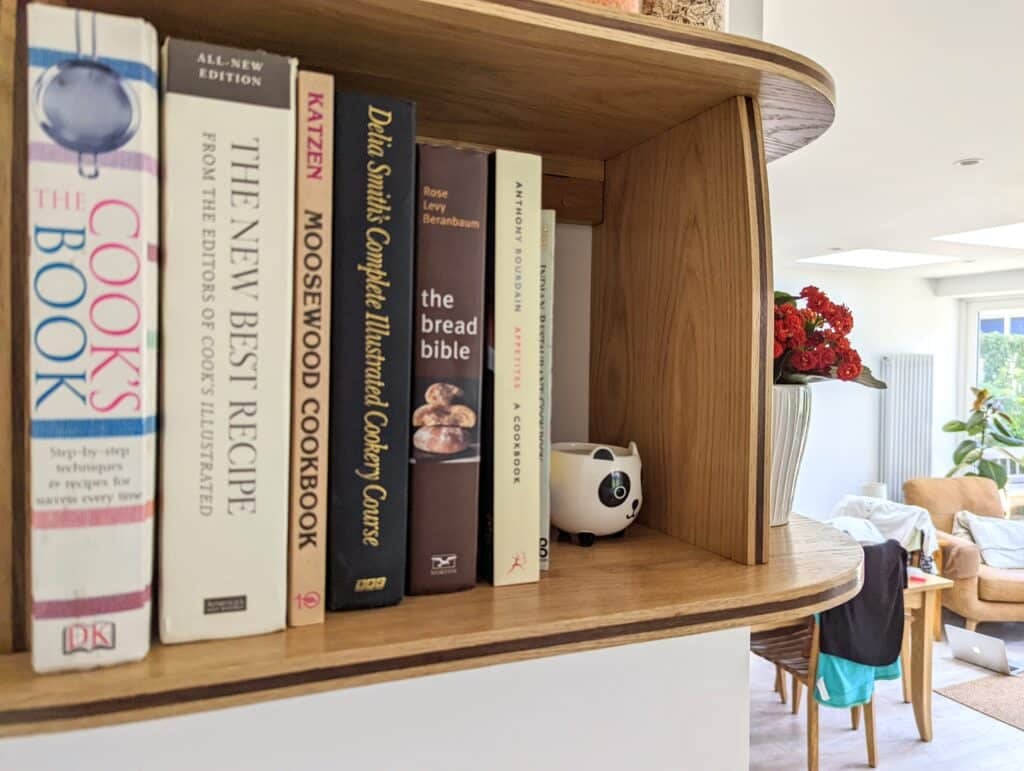
Some corners are best filled with small units be they mirrors or wall shelves. I had one corner that worked for a recipe bookshelf so I made one as an instructional for sliding dovetails. These are housing dadoes with tapered and dovetailed walls. They take some calculating but in real life back in the late 1800s they were not laid out as we might today but simply cut by eye with a tenon saw cutting the walls and also the angled aspect of the slide-in part. Hard to price this one. I added a little inlay to the edges just to add a little extra dynamic. Best part of a good day’s work but I couldn’t really charge too much for so small; a shelf unit. $150??? Some pieces you have to take a loss on.
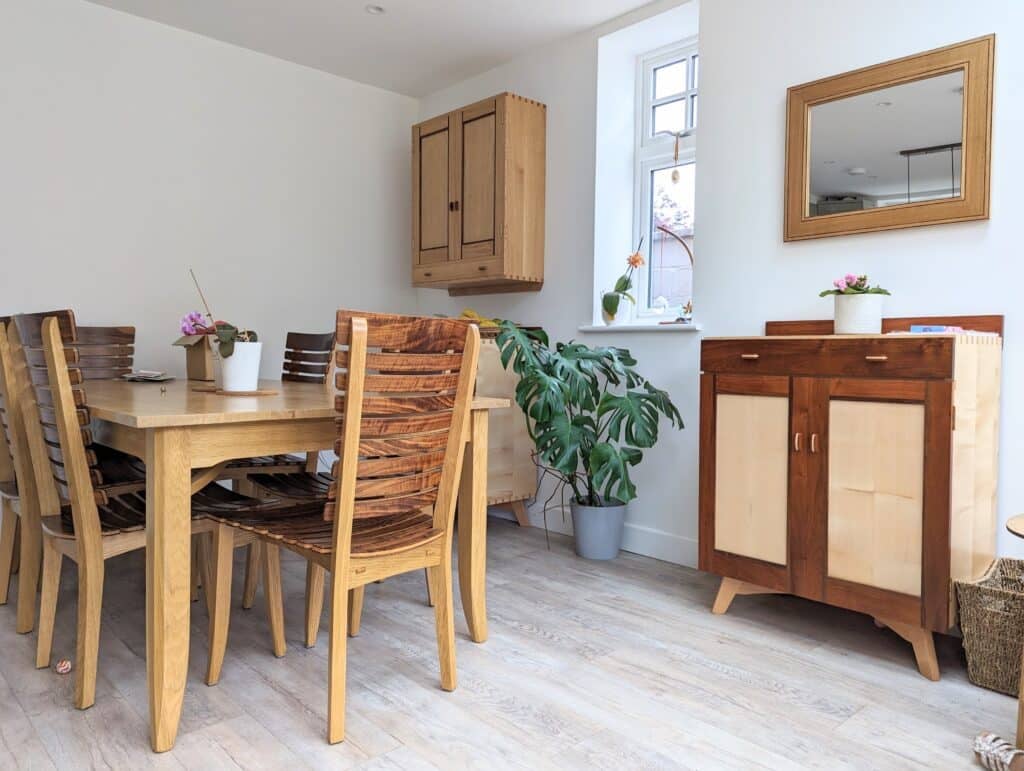
I designed my mirror frames and came up with a variety of design types using mortise and tenon joinery on the corners and then facings as a veneer of built-up contrasts. It worked really well. I have one as a mirror and three others as a cluster group of my artwork. The pieces are really well worth $150 each. That being so, $600 for three days work.
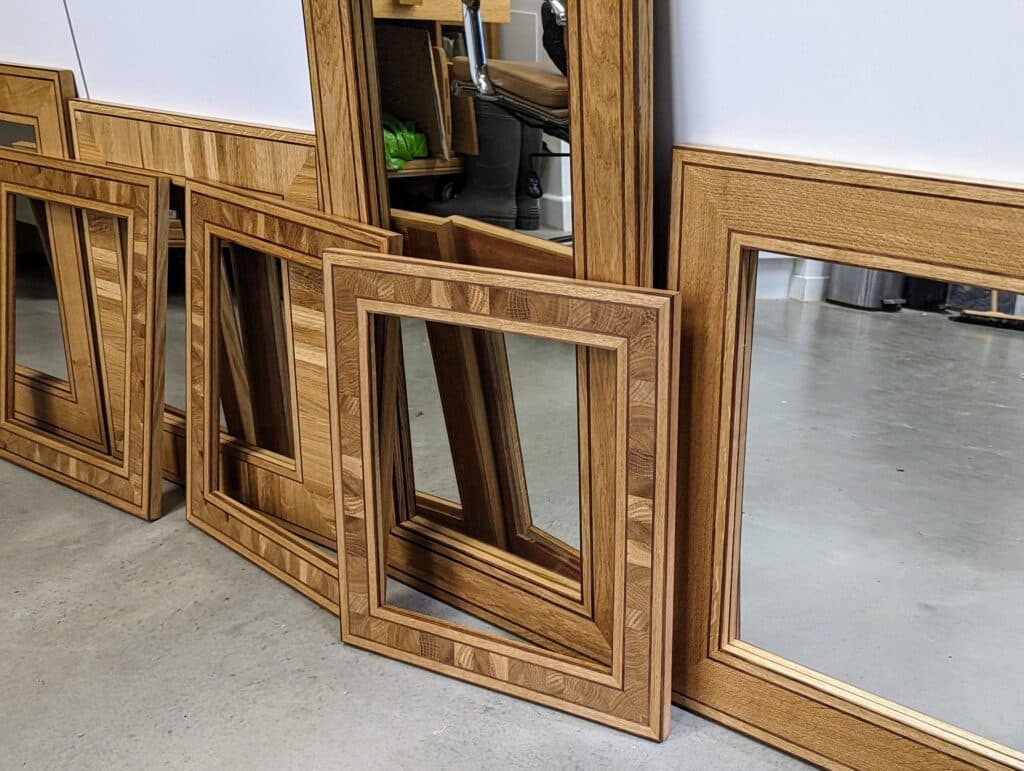
I also have two elliptical side tables in this area so $800 for these.
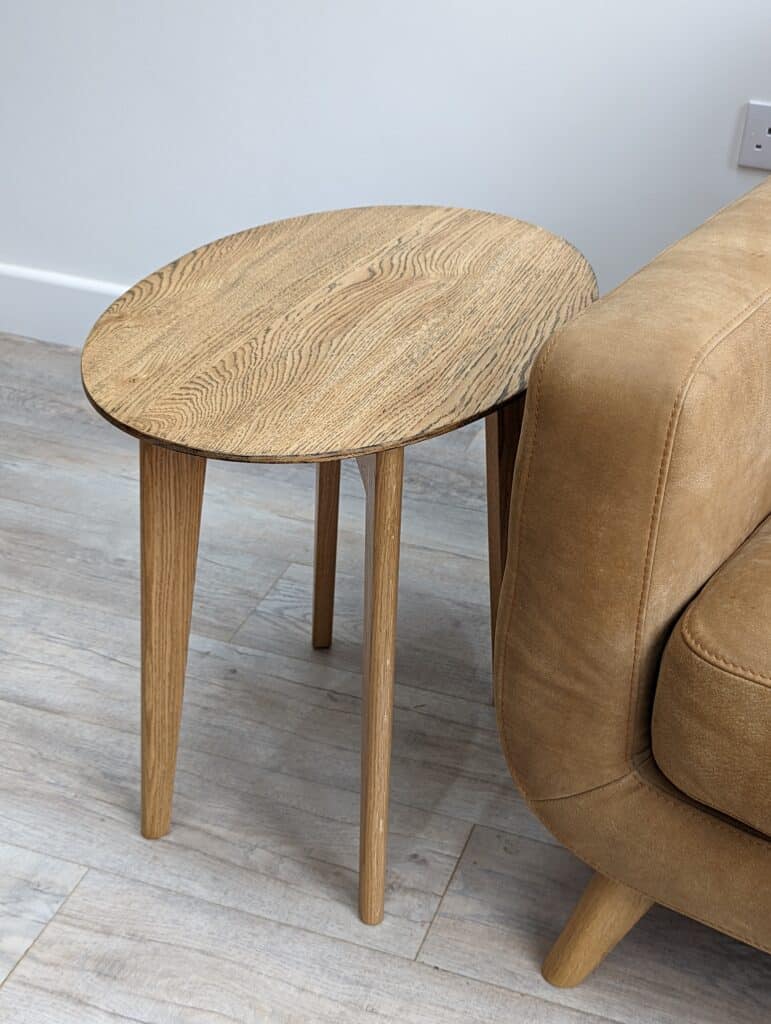
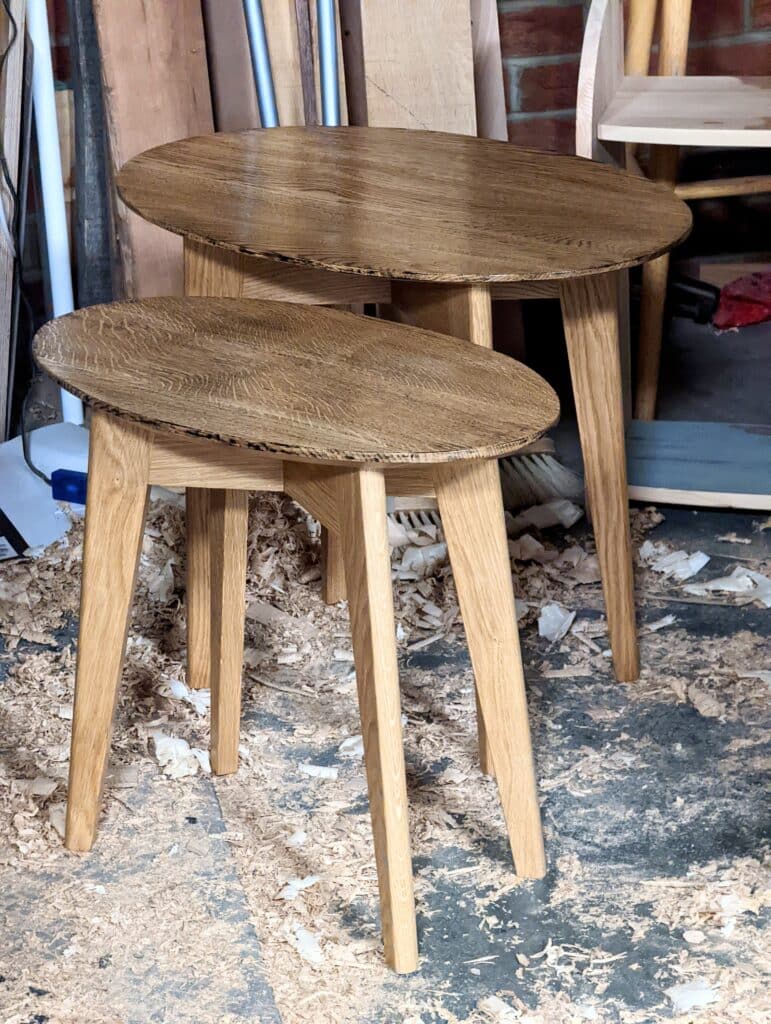
This totals my dining area furniture to $22,050 without the additional three chairs and the second wall cupboard. The days come out at around 60 days of work so around $360 a day less materials, etc.
The hallway is yet to become a place for hanging coats and other things but in my mirror-making spree, I made an elongated version to hang there.
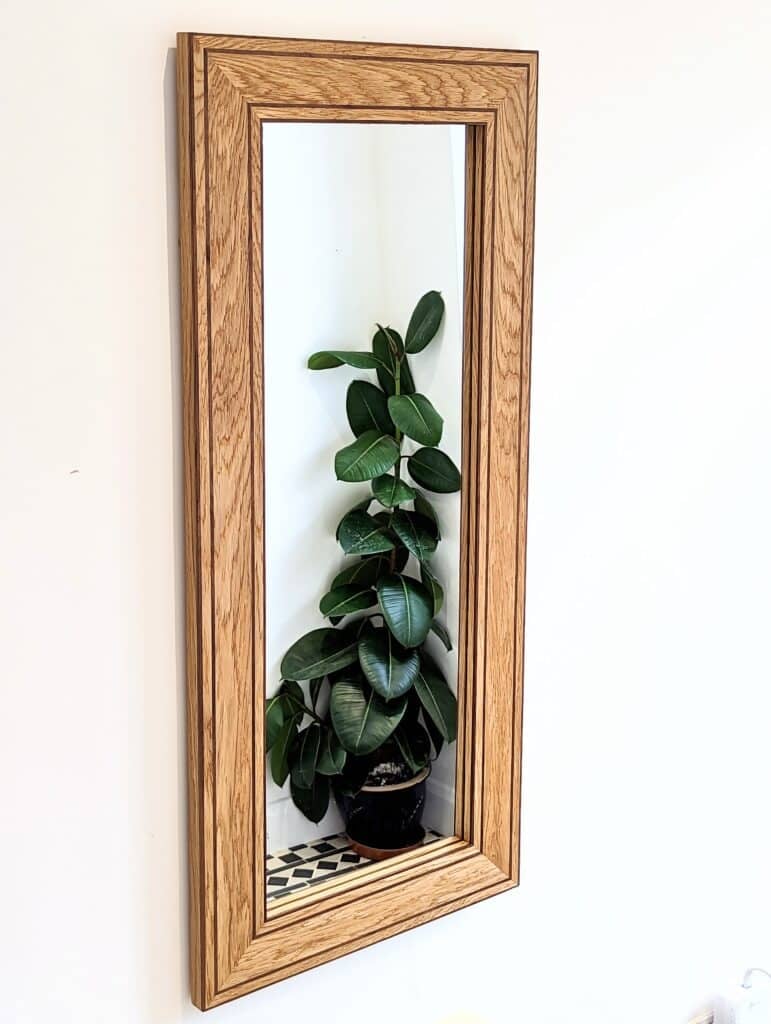
I think if you take the total 90 days and put them into the 730 days of a two-year expanse the percentage of time might actually surprise you. Split these into half so 45 days or roughly a day a week.
Upstairs now
We will make furniture for two bedrooms with the first being the master bedroom. We concluded the main body of work two weeks ago and began this series with a kingsize oak bed.
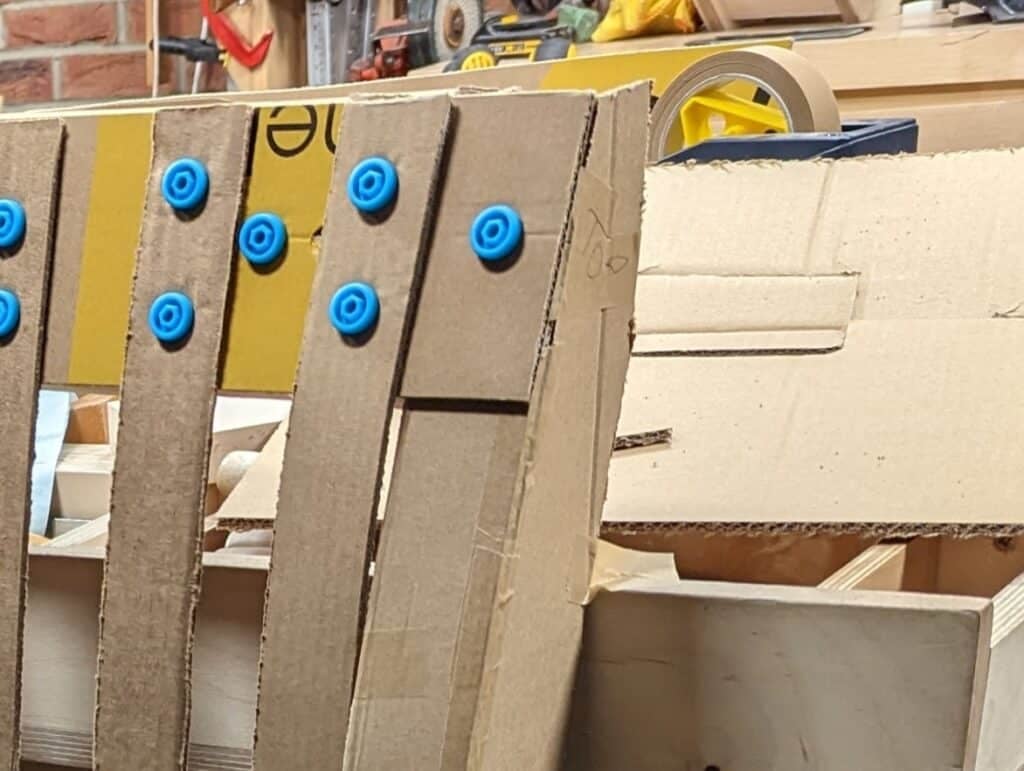
This facsimile of the bed I will ultimately make from real wood is made from corrugated cardboard boxes repurposed for temporary life as a space and placeholder. You can now see the real value of spending an hour or two on such a model to pass on the full impact so large a piece will have on a room. It’s also a great way to show your intent in the design, albeit roughly. When the team Rokesmith saw it in situ it increased their awareness of what would otherwise be arbitrary to them as visualising size and shape can be heard. Also, it’s fun to get grandkids involved if you can.
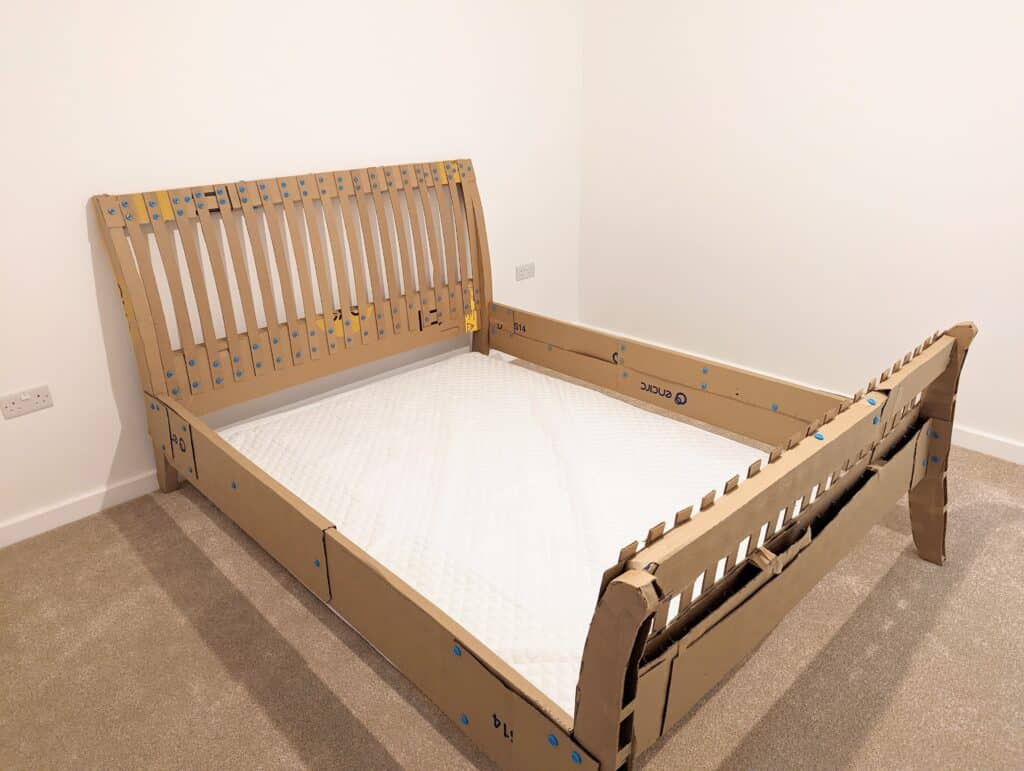
So gradually the project came together in my very limited garage space. Most of the work is on the benchtop and in the vise until the head and footboard come together as primary units. Everything else is just sticks and stems for side rails and cross bearers to hold the mattress.
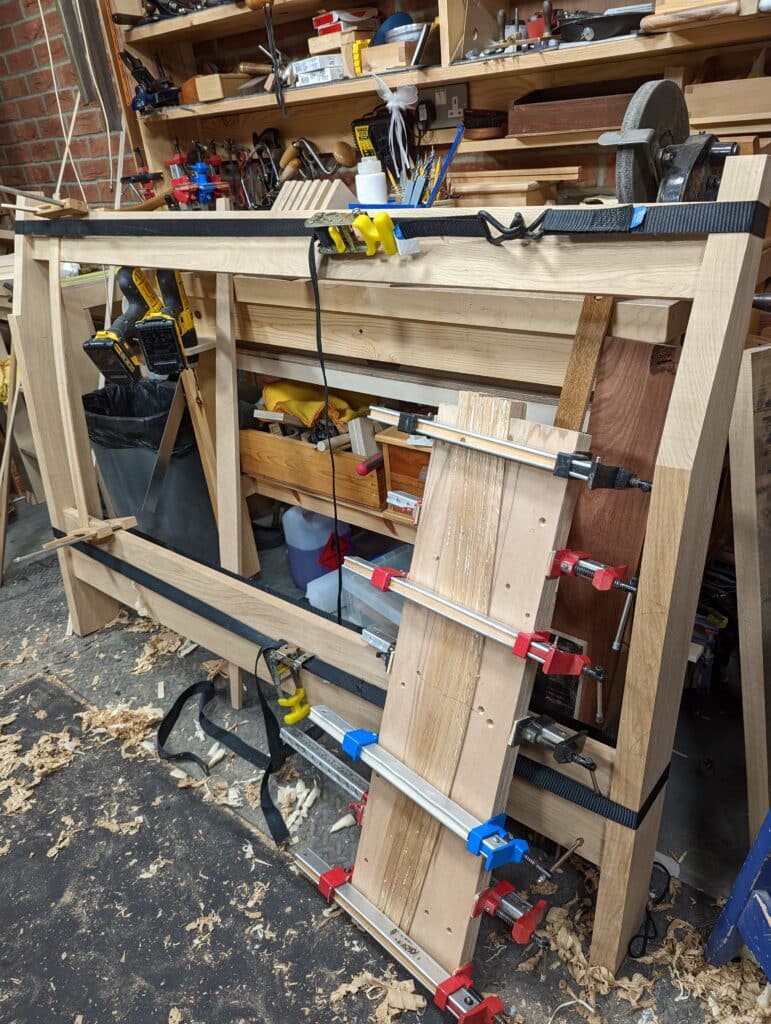
I started on the 22nd of November 2022 and it took me until the 4th of January to deliver it. It took me three weeks of actual work to make the bed––15 full days. I know that the wood cost $400 this time.
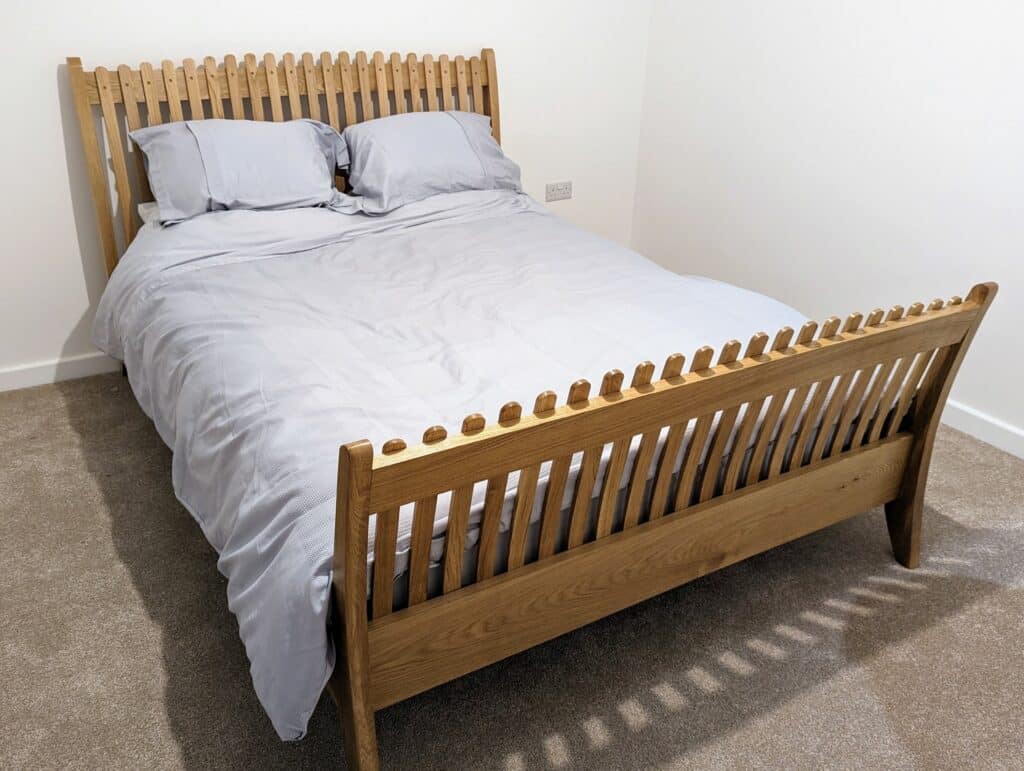
The bent slats are triple-layer laminations and the joinery used throughout is mortise and tenon. For this bed in this size, I would charge at least $3,000 and I never had a bed that didn’t sell for a price in this range. Also, it is good to remember that a twin (single) bed takes the same amount of time to make as a king so you have to be careful when pricing for children’s rooms. This bed is not at all complicated to make and much of the work is repetitive. It’s important to establish the main locus first as commonly this establishes the space available and the location possibilities of subsequent pieces like chests of drawers, bedside cabinets, wardrobes and so on.
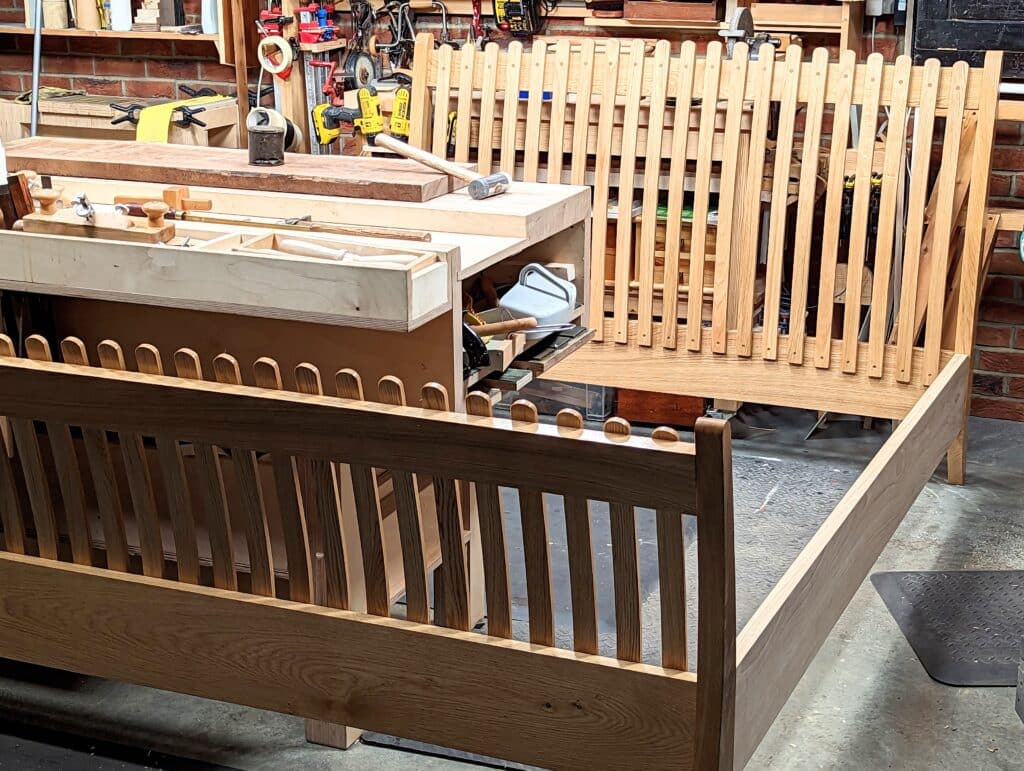
I moved straightway onto the bedside cabinets. Making two meant the first one could be my prototype. I loved the stripy look of the tambour panelling I did for the living room TV stand which had lots of strips of mixed woods gathered over the previous weeks. These made the side panels and the door fronts. Yes, it’s different but I felt quite lovely. Then too I focussed on different handles shaped again from scraps.
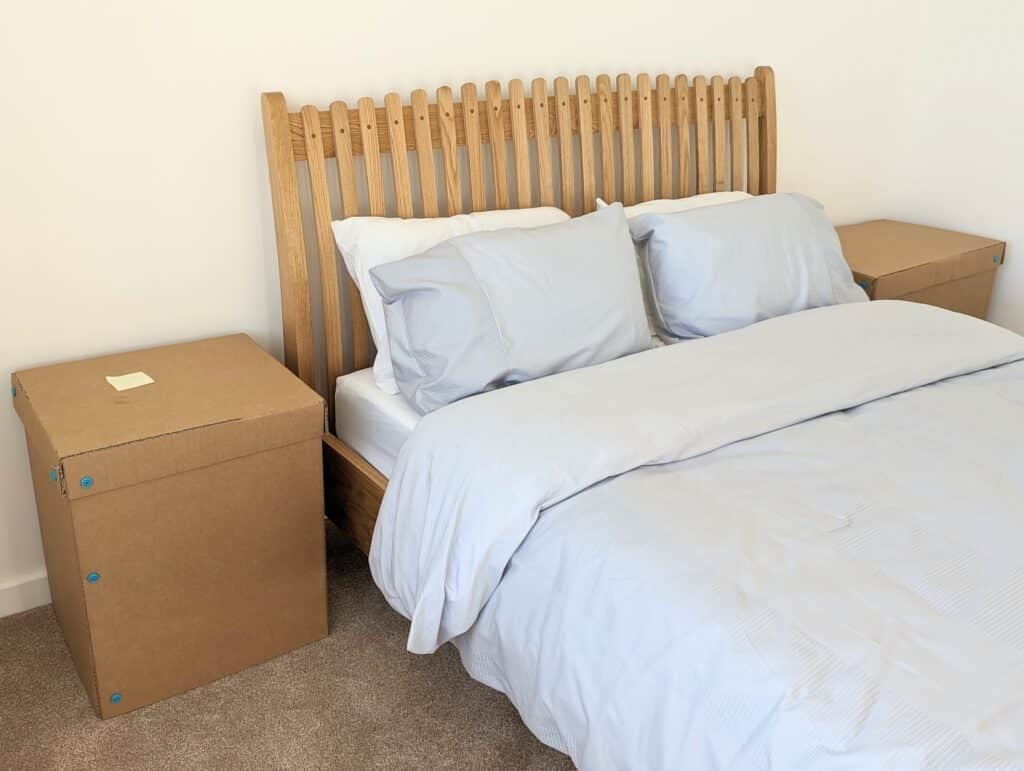
The pista resistance came when I put a screw through the middle of the dovetails so I could keep working on the pieces. the screw of course would never be seen. For some reason, this drew 4.8 million views on my Facebook page with 2,000 comments and 12,000 likes. These two pieces would come out at about $2,000 each so $4,000 for 12 days work. The design itself is worth an additional $1,000 but I’ll leave that out.
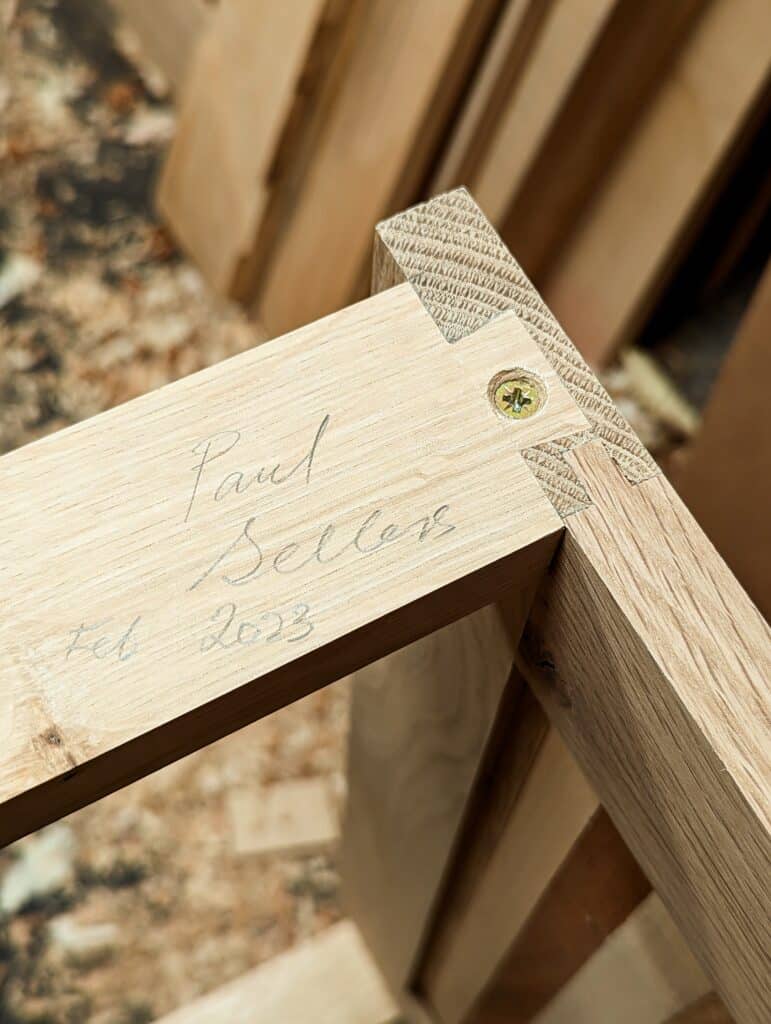
The solid feel of the finished cabinets was truly rewarding. It’s important to note here that none of the pieces made using this panel-type construction has caused any issues anywhere and I will continue using it in my work in the future.
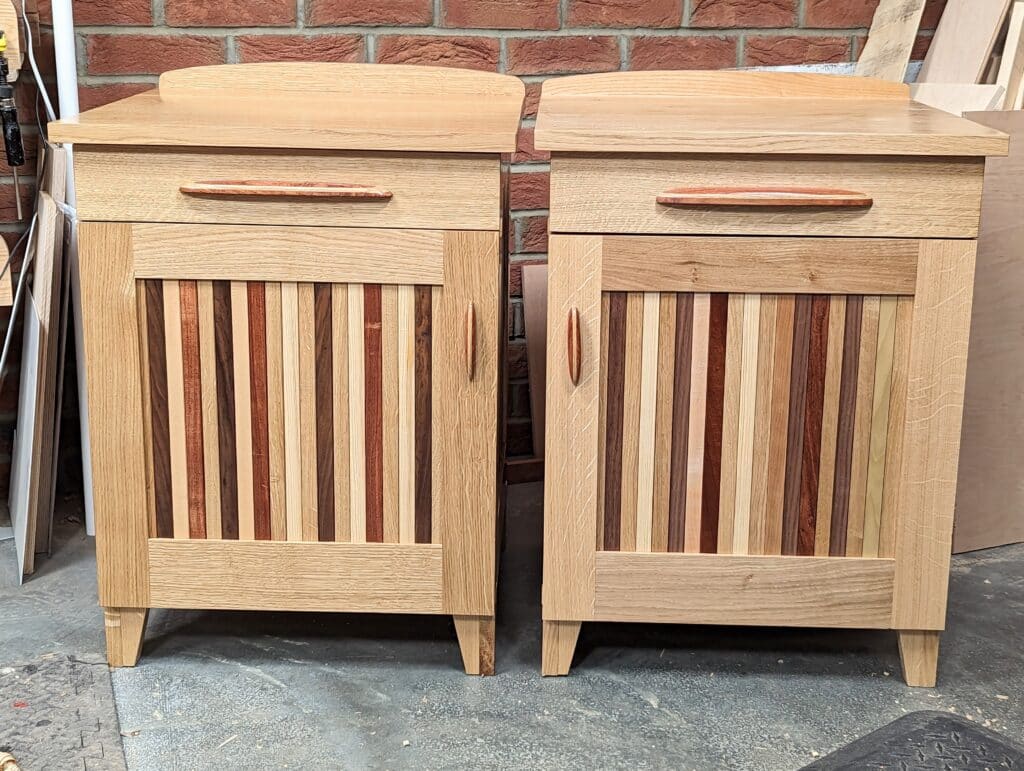
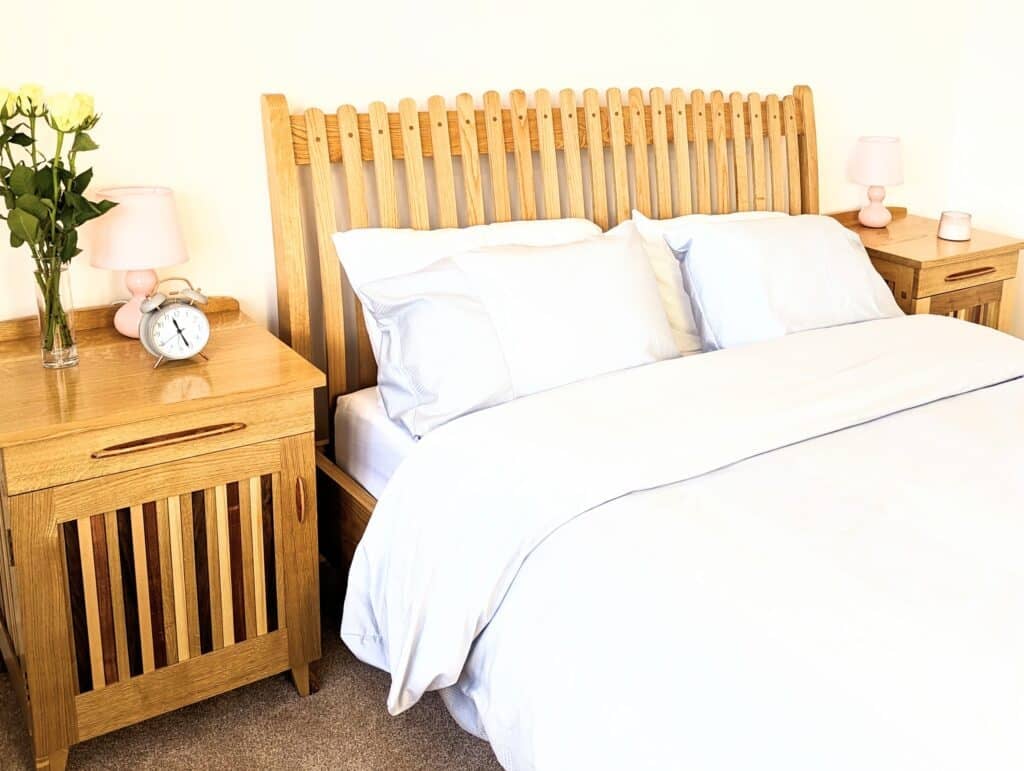
The greater challenge for the bedroom was the wardrobe. The dogleg staircase meant I could no way build the whole as a single piece item. It would need to be a flat pack. Basically, I decided on eight panels of different types including framed doors and side panels and then plywood panels lipped in oak. It worked brilliantly. I took it from the garage workshop into the house and up the stairs, around the bends and into the bedroom no problem. Adopting the tambour look yet again really worked for me. I ripped any strips left over from various makes into strips of random widths up to 1 1/4″ wide and from 3/4″ and jointed and edge-glued them into the frame as panels. It worked and gave the piece the dynamic I wanted. The wardrobe is three weeks’ work really. Fifteen days. Cost? I think $3,000. It might be hard to go much higher.
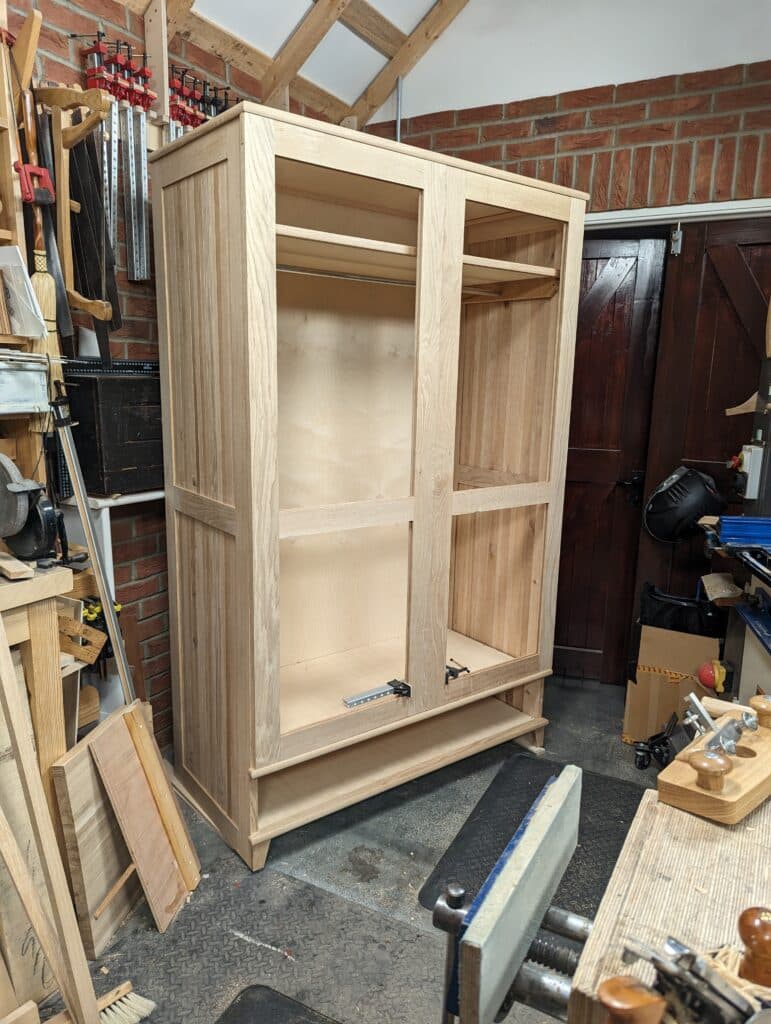
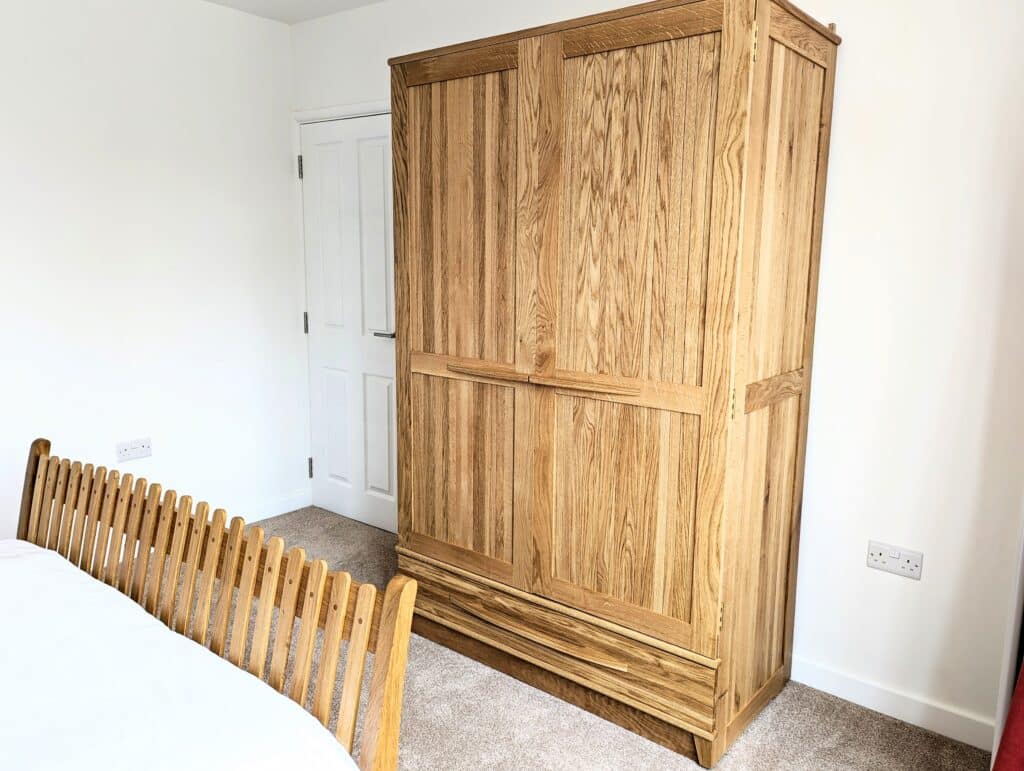
Chests of drawers have twice as much work as that seen from the outside. the same is true of the work it takes to make them. Allowing a day for each drawer is a luxury but more realistic if you use only hand tools and I would, could never ever use a power router and jig to cheat myself of the wonderful experience I always, ALWAYS, get from making a drawer with hand-cut dovetails to the corners. I doubt that power equipment would give me much gain in terms of speed in the actual dovetailing bit. 20-30 minutes per joint corner by hand is a good speed using my unique method and no one but no one uses this system anywhere in the world.
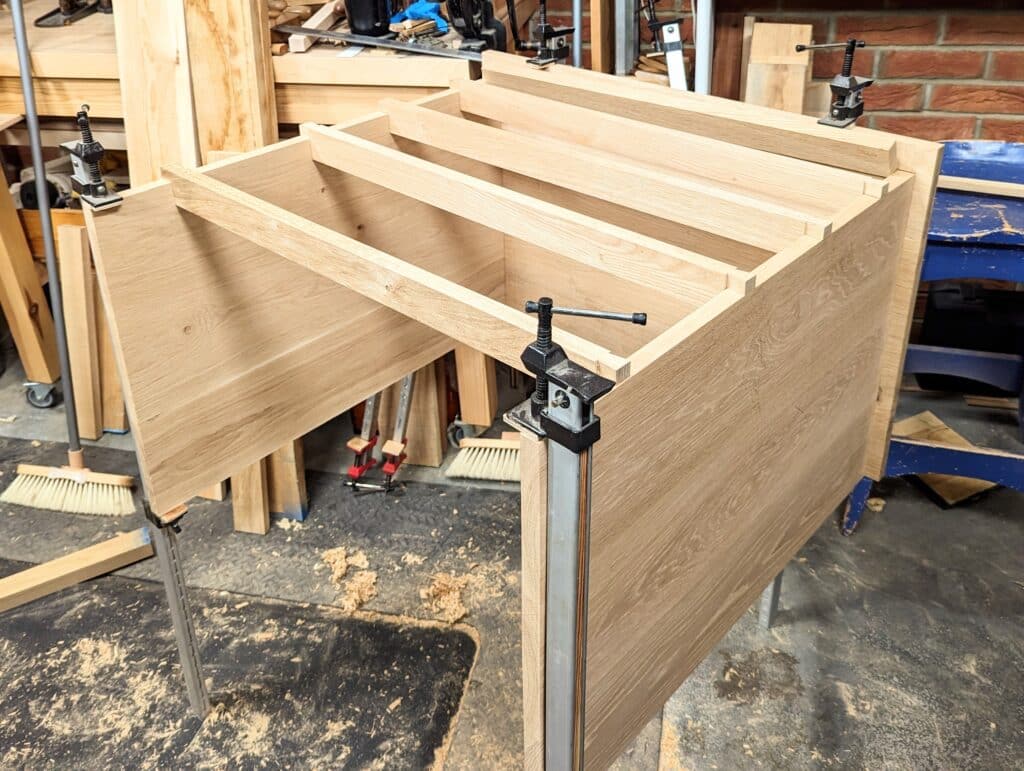
The chest came together remarkably quickly. carcass first and then the drawers in diminishing sizes. Sliding it into place gave me the buzz I always get on delivery and installation. I had made a box-size version in cardboard to check for positioning and worked to that end in the overall sizing. It was a simple piece to make. Two days for the carcass, four days of drawer making and fitting and two more fine-tuning and applying finish. Eight days in all. $2,000 is a fair price for a robustly mad lifetime heirloom piece like this.
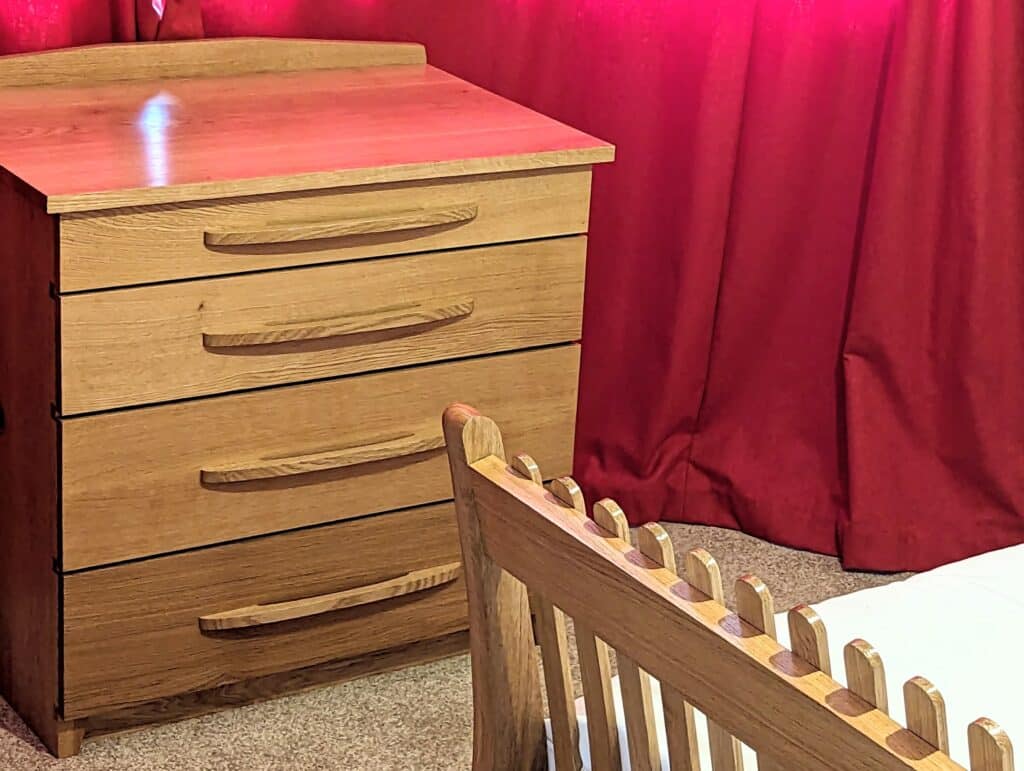
All of the large components fit the size and shape of the room. They can all be moved to any one of the three available walls so I achieved the ability for change in years to come if ever desired. This was an important ingredient.
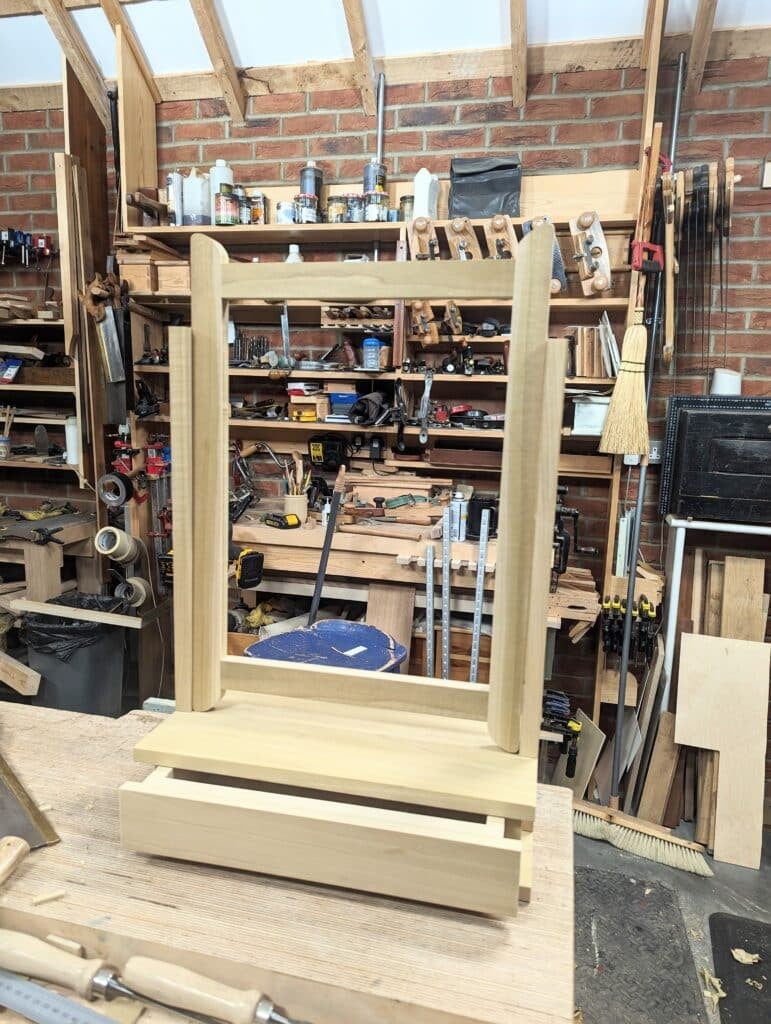
My last piece for now was the mirror stand with the tilting mirror and the small drawer. I want this to stand on the chest of drawers, the obvious place I suppose. This is an excellent reinforcement project for new woodworkers in that you have dovetails and housing together with mortise and tenon joinery for the mirror frame. it’s also a good saleable piece. For me, it is a day’s work steady. An hour and a half for the mirror frame and then the stand is about four hours. The rest is the finish time and mirror installation. £250 with the right wood would be a fair price. This is also a project I might make three or four of as a small batch production run. I actually made two such pieces. The poplar one looked just as nice as the oak one. Let’s say $450 for the two.
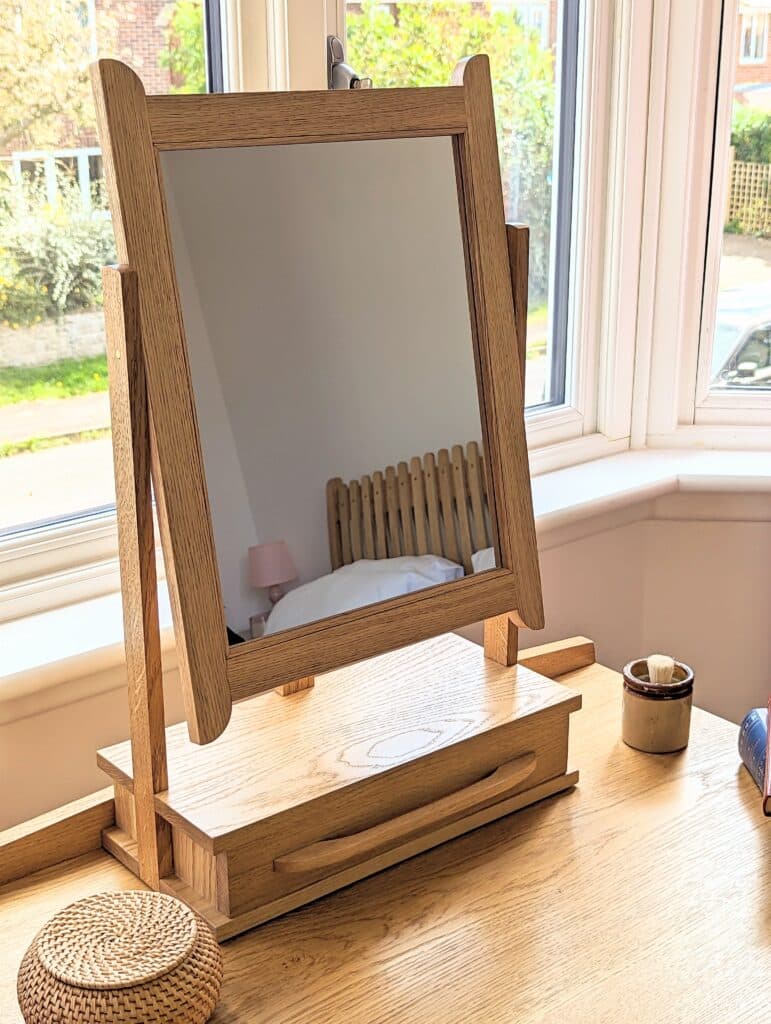
I think you would save a day and comfortably make four in three and a half days that way. Not taking breaks and repetitive processes makes you more efficient without being overwhelmed. For instance, splitting the project into three principal areas would mean making the four base units of the stand first, followed by four mirror frames and finally the drawers.
My workdays come out at around 52 days with a gross income of $12,500. that’s ten weeks of work so I would need to increase my prices for the design work if I were selling but, of course, I am not, and that is more to the point. This ‘homework‘ defies valuing the way I just did, but it is a viable way of assessing that you are not losing money by making your own furniture for the home but gaining financially and in the quality of what you make along with the quality of life and I can indeed make a living and the living I want from hand work making my furniture with a lone bandsaw. As a known maker and working on new and unseen designs I would double my prices at least and change my production on some of the pieces to make two or three at the same time.
Included in this work have been so many other things I do with teaching and training, writing, drawing, designing and such. My granddaughter of four came in Thursday afternoons to make and learn. I actually made about 18 router plane designs to compliment my range and then an additional 15 of my unique picture frames the like of which the local framing shop said he had never seen frames so beautiful and unique.
The value of what’s made is of little relevance here, but I put it to counter how some will present their point of view in saying no more than, “In the real world. . .” or “You can’t make a living working with hand tools.” when it would be better put to say something like, ‘I am not trained in hand tool woodworking so I personally could not make a living using those methods of working.’ Even if you halved my prices above, living within your budget would mean making choices but you could live and provide for a family on a single income as I did in fact for decades.
The fulfilment from this work is the greatest reward and, of course, no price can be put on the benefits. Walking through the rooms filled with what you made is to almost repeat two years of therapy.



This post is so instructive and didactic business-wise! Much appreciated! I think I will copy it and keep it in my documents for future reference.
Sincere thanks!
Would you clarify one thing, please? When you say you are giving prices based on your experience in the US, are these prices you would have charged back in 2009 and need to be inflated to 2023 dollars? Or, are these estimates the prices that would be asked for today?
This was an exceptionally helpful article. May people say you should just multiple hours by a shop rate, but this has never made sense to me. In your examples here, you adjusted things to reflect you experience of what people are willing to pay item by item. So, for example, although the hours are the same, the rocker sold for more than other items. This makes so much more sense to me and I’ve always been stuck because there is simply no way to guess at these numbers.
Ignoring other factors, did you find that carved seats sold for more or less than seats upholstered with foam and fabric / leather?
Shop rates work in production cabinet shops making competative carpentry as in kitchens and bathrooms but that is not the same work as furniture making even when machines are used throughout both. Rarely does an hourly rate work where handwork is concerned simply because the type of work dictates what people will pay. I could spend six days on carving a floral medallion 6″ in diameter but because of the skill level and the rarity of skilled carvers around my rate would be higher than the cabinet shop where I could pick from fifty shops in medium sized town. Hence the work I once did for a restoration of a winery where carvings were ordered said you can pretty much name your price and the owners will pay it. They gotta match and we gotta have em so go ahead. name it! Yes, inflation makes things ultra fluid these days these prices are based on what I feel hand made work is worth from an unknown maker. Generally the carved and shaped seats are more desirable than upholstered but upholstered can be more comfortable. Rocking chairs are forever popular stateside, more-so than the UK. I think rocking chairs are more an American thing. My Brazos rocking chair design (very similar to the one shown above) sold for between $4,000 and $6,000 before I left 2009. They sold consistently as a regular item.
Paul — Your work and instruction changes lives! That you for the knowledge, shavings and sawdust.
Very interesting post. In today’s world, I don’t know if you could buy all these pieces from only one maker. And that’s what makes the pieces in Sellers Home so valuable. Paul started with a design vision and was able to carry it through all these pieces. That overarching design concept by itself is probably worth $10,000 to $15,000 – probably much more if the maker was also working with an interior designer. I think Paul has priced his work as one-off pieces without taking into account the value of the overall theme. It’s just a guess, but I think it would be very difficult to find a single maker or a small shop that would be willing to invest the time to come up with an integrated design for furniture to fill an entire house. Paul’s videos and the integrated design are priceless.
This! There’s so much involved to the intrinsic value of this entire masterpiece.
If the result is owning all these pieces signed by Mr. Paul Sellers, I’ll take one of each please! Where’s the order form? I’m mostly kidding, but could you imagine what these would REALLY be worth? Paul, you are pricing them based on market value for the pieces alone, and yes I understand the point of the post is to gauge the price any of us mere mortals might expect to ask by replicating them. But years from now these very pieces in the Sellers Home will be worth a fortune, simply because they were designed and made by you. And not a small fortune, a real fortune. If you’re offering these for those prices now, I’d gladly purchase them to ensure my future generations are set for life. 🙂 So about that order form…
Rather a sweeping statement, some of us professionals do work by hand my self included. I have just made newel, cape for stair case entirely by hand, most of my work is done by hand.I am personally fed up with you slating, us. Yes I know a lot don’t know about hand tools but some of us do. I was trained by men who if they were alive now would be well over 100 years old, and I hope my work does their memory justice.
It’s not a question of slating but more stating plain truths. We are on our way out, the last of a dying breed. Most such don’t even apprentice others these days, not in our craft at least. I just think it is important to be straight talking rather than pretend all is good with the world of what woodworking has become for most. In your world you’re saying, ‘Hey, we’re all okay.’ You as a lone hand tool woodworker putting in a hand made stairway doesn’t mean we’re solving the problem or indeed that noone is doing things with hand tools. I venture to say that amateurs using hand tools now outnumber professionals using hand tools a ten thousand to one. I will go a step further and say 98% or higher of so-called professional woodworkers do 98% of their work, no, 99% of their work, by machine or stuff with cords and batteries. There is absolutely nothing, nothing at all wrong with that. just the hard reality we now call progress.
Where can we buy the plans for these beautiful pieces! My grandfather taught me how to use hand tools! Just FYI. I would love to buy the plans.
Thanking you in advance.
Marianne
All of the pieces being made are on our website https://woodworkingmasterclasses.com/ the you will go to https://sellershome.com/ where the videos on making each piece is offered in various series and episodes.
Very interesting article. Thanks for sharing the pricing on the pieces.
I know where I am, the cost of the hardwood is very expensive, which tgakes a large chunk from the actual selling price(s). I have not encountered many people (yet) that appreciate the handwork and will pay the extra cost. I think many people (customers) have no idea of the cost of hardwood and the amount of time required for handmade furniture like this. Not their fault. They just have no experience building something by hand. The only point of reference for those who don’t know is IKEA furniture prices. I’ve built handmade canoes out of wood over the years and when I have gone to sell some, I was never able to get reasonable selling prices. It was like I worked on them for $2-3 dollars an hour. For now, I just make wooden items for myself, friends of family members. That has been my experience.
very true.
Sad but true. I carved a very large bowl for a friend and colleague who had given me a big load of wood to cut for the fire. He was a super good man, with a nice family so I was happy to give him the huge bowl :).
He later asked how much it would have cost, I truthfully said what I thought: hundreds of pounds but likely nobody would buy it at that price ( I’m guessing).
BTW the bowl was made from a huge, knobbly piece of the wood he’d given me. So he provided most of the materials 🙂
What I find interesting about this piece Paul is that I suspect that most of your income comes from this website and not from making individual furniture pieces despite your insistence that a living can be made out of selling hand made pieces.
Your own website and business model goes against all you say about this.
If you were selling handmade pieces and making a living from them then this website and it’s courses wouldn’t exist.
It’s one thing to talk about earning an income from hand made pieces but another thing to make them and sell them to make a living.
This is not to say anything about your very obvious skills of which I am an admirer nor your previous work in the States, but today’s reality would suggest something quite different from what you say.
It is incredible that you continue to say such a living can be made yet make your living without relying on selling handmade furniture.
Just thoughts .
Regards
Gerry
Paul and his workers made and installed the cabinetry for our nation at the Whitehouse. his reputation is impeccable and he has earned much respect from all of us. you sound like many of the millennials who have little respect for past accomplishments. regards.
What is more important is that Paul made clear that he is describing prices a new builder might receive based upon his experience when Paul _did_ earn his living building. The fact that his attention has turned to teaching now does not invalidate his past experience. Further, Paul has written many times of his belief that people expect too much and, as a result, take on high-wage jobs. One way to understand this article is that it lets you estimate your income if you choose to build, assuming you can find a market and can guess your productivity. If you work that out, I think you’ll find it isn’t very much, especially in the US where you must pay for healthcare and Social Security. But, Paul has written clearly that his belief is that this lower income is preferable to the high-wage jobs. So, one needs to decide for oneself whether this is what one wants and whether one can find satisfaction in the work itself and be content.
disregard please my above post. I misinterpreted what overall was said. thanks. Tom Peterson
It saddens me to see responses like this. I only made a living from my online work in the last decade. What about the previous 48 years as a full time maker of daily making and supporting a large family and that on a single income not two? Come on. Let’s not get bogged down like this. I encourage people because of my belief that if I can do it, anyone can but that is not what i am actually promoting. I am simply promoting the idea that some might have the courage to just make their own furniture as I have just done in the last two years. I accept that this is just a distraction from what was actually said but why?
I come to this post several days late (covid is my excuse), but I recall seeing your work offered and sold in central Texas long before the Internet was ‘a thing.’ If Internet activities provided you with even a gargantuan income, it would be a pittance against the value of what you teach has for your audience, and very much well earned and deserved. It’s clear to me that while you (Paul) might have made some income from teaching classes, my knowledge of the rates charged for those classes tells me that it would have been little compared to what your making furniture produced.
I might be wrong but it would take some convincing to sway me.
The post was intended to point out the possibilities for a hand tool woodworker for the machine tool woodworker or hand tool even, who proclaims it can’t be done. This post shows that it can.
The fact Paul has chosen to move onto a path of preserving these methods, and passing the knowledge onto future generations, I suspect at the start had nothing to do with income. Possibly, (and I hope Paul won’t mind me saying so) as he is reaching his senior years. He is looking for a slightly less labour intensive way to make a living. Working in manual labour for this many years takes its toll on your body. As a tradesmen I can confirm this, and at 43 I’m already looking for a way to work smarter not harder as the physical ailments begin to show. And I have considered passing on my knowledge and earning through teaching to make life a little easier. Or even leaving the trade altogether.
The income stream created from the website I think was purely an offshoot, caused by the amount of traction gained, as people began to realise they were watching an absolute master at work. Mostly for free, And with such great instruction that it was possible for me; with very little woodwork knowledge. To build a bench in a couple of weeks and, to quite a good standard . Yes some of that has to do with my ability to pick things up quickly, and already having a trade background I would say helps a lot But , mostly it was as I said, the level of instruction, and I’d like to say Paul’s cheerful, optimistic and anything can be achieved attitude.
So to sum it up. I don’t believe for one second there is any misleading information in this post. Or it is a case of saying one thing but doing something else. It is merely a matter of circumstances which I doubt you have considered enough. I have so much respect for a person like Paul. I’ve met so many people in construction with a “that will do” attitude. Nobody holds a tradesmen to account generally other than themselves, who understand what is and what is just not good enough. it is a measure of character of the man, that even though he knows exactly how to cut corners, if it will diminish the quality he doesn’t. That I felt compelled to comment
myself on what I felt was an unfair or unthought out statement
Spot on Jon!
Thank you for including so many beautiful and inspirational photos.
No, thank you, John. So very inspiring for me to see such a positive response for something I just love to do. I really appreciate it. It takes a day or two for me to even write this kind of blogpost. To do the research and try to present truth.
To be fair to Paul, I don’t think he runs his web site to make money, rather to preserve the craft and give joy to his followers. After we had a fire in the house, I made doors and windows, tables, and chair, and I’m just starting on the last wall cabinet for the new kitchen – mostly from what I learned from Paul.
I’m sorry to tell you this, Paul, but I don’t think I’ve given you a penny for all this! But I can send you the gratitude of a man who sometimes struggles financially but has been given satisfaction, pleasure and a little dignity through learning hand-tool woodworking from you.
Wow, wow, wow! This is exactly why I do what I do.
Excellent!
Sellers-Nomics!
An incredible story of how you’ve filled the last two years of your life, and the incredibly hard work you do day in day out. Where do you get your energy from ? I know you’re no spring chicken, but your enthusiasm and energy would easily equal a 25 year old. I salute you for your sheer dedication and enthusiasm. Thanks for sharing your stories.
Respectfully. Paul.
What an interesting and provoking question, Paul. I would say I am slowing down but even so, here I am on Saturday evening at 9.30 answering your question. It’s who I am and what I do. I do it from choice. I don’t like grass growing under my feet. My life is not part time, parcelled off in bits but a complete whole. My day off today was two hours writing from seven till nine, a short half hour break and then another hour and half writing (That’s how I start every single day BTW). At 11 am I spent an hour mowing grass and enjoying the company of my family over the next three hours. I enjoyed mixed cheeses and low carb bread and then I slept for three hours because its weekend and no one is depending on me. My normal working day is two to three hours of writing and eight hours of physical working at the bench followed by an hour or two writing in the evening, if I want to. When I was diagnosed with non-curable disease back in 1985 I researched all that I could and radically changed my diet. Over a few years the incurable disease was no longer present in my body and the surgeons were indeed amazed because I never took any of their advice or the medications I knew would indeed harm me. When I was officially diagnosed 15 years ago with diabetes it never slowed me down or stopped me in any way. I actually knew I was diabetic seven years before then. Gradually I changed my diet and I feel that diabetes has helped me so much in my day to day life I am actually thankful that I have it and would rather own the restrictions it brings to my life than have the freedoms to eat anything I want or like and suffer the long term consequences of such freedoms. I am vegetarian for about four good reasons and will be unlikely to go back to eating meat. I research my food and cook accordingly. I never gain weight and have to watch that I do not lose too much. At 5’10 1/2″ I weight 167 lbs and my BMI is 23. I insist on exercises several times in my day, 5-25 minute sessions periodically interspersed but always starting the day first before I eat with a 20-25 minute cycle ride before breakfast followed by another half hour cycle ride after writing and a cooked vegetable breakfast. Also, remember that working with hand tools is just about the very best physical and mental exercise you can get. It’s consistent, high demand and also demands total brain engagement to resolve the perpetual problems you do not get as a machinist. As i say, hand tool woodworking is high demand woodworking. People fail always to see and understand this. I try to help people, woodworkers using only machines, to see this but it is hard slog because, well, as humans, our bodies will from choice always choose the path of least resistance. Anyway. I am slowing down and at work I will now comment that I am tired now and then, something I never did until I reached being 73. Of course, we non of us no the day nor the hour. Best to make the best of every day.
Thanks Paul for sharing. There are some areas in the world that have what have been called blue zones. These are areas in the world which have disproportionately high levels of folks live well into their 90s and reach 100. As you might imagine, this has been investigated to understand what folks are doing to reach these ages. Though the specifics are different, they can be categorized into different “buckets.” Movement/physical activity – Okinawa Japan they don’t have traditional chairs and sit on mats as such they are getting up and down 20-30 times a day working their core muscles and lets; a town in Sicilia is on a steep hill and the individuals walk up and down the hills a lot helping them work cardio and legs. Food – differences but similar healthy veggies and protein. Culture and sense of purpose/belonging again specific differences but same thing. As such, much of what you have written about in your lifestyle above and over the years mimics what these individuals do that lead to a long life.
At 55 now, I think about what my life will be like when I want to slow down at the day job. It will be a mixture of physical activities (good portion hand tool woodworking, bike riding, and walking), community and family (church, teaching at local university for fun/fun money, family/close friends), food (I’m partial to the Mediterranean type food), mental stimulation (woodworking, teaching, science, travel). Similar to what you do in many ways. It’s a good way to live I think. My grandma made it to her late 90s, my dad is in his mid-80s. Both of them kept active and I think that is a big key.
When are you coming back to US? We are desperately short of good guys since you left.
Reckon you’ve noticed in the news what a mess.. or, maybe that’s why you upped sticks ?
I am planning a two week period next spring, all being well, Lord willing and the creek don’t rise. But who knows in this crazy mixed up world.
Amen
“You can take the boy outa Texas, but you can’t take the Texas outa the boy”
I should add that no country or continent is escaping the stupidity of messy politics, economics and such. We just have to take the limits of our own habitation and make changes within our own human limitations as best we can.
You made a comment Paul a few years ago, during the height of Covid. that stuck with me. Something to the effect of “today has enough problems without worrying about tomorrow.” The one thing I did to help feel less stressed about politics, economics, etc was to stop watching the news on TV or reading a newspaper. In the morning, when I get up, I hear the news on the radio and that is just enough info. My mental well being has greatly improved.
Thank you for this article, very inspiring, as always with your blog.
But I feel like in trying to show that hand tools woodworking is viable, you kind of show the opposite actually ; let me explain.
I’m not surprised by the prices you mention, as your work is certainly worth those but it comforts me that nowadays only rich people can afford handmade furniture (or maybe furniture makers only make for rich people, but what came first ?) And we’re talking about pretty basic furniture here, no carving, veneer, inlay… that would justify being exclusively accessible to big budgets
A few decades ago, middle class could afford well made furniture (handmade or machine assisted that’s not the issue here). My grandad, a rather poor farmer and father of 11 children bought all the chairs, beds, tables… of the house from the local maker. It was nothing fancy, very basic but extremelly well made and still in use after all the time. I don’t think that it’s something he could have afford nowadays.
When you say that hand tool woodworking is viable I wish you was talking about this kind of basic but well made furniture that everyone could afford, that’s those kind of makers that disappeared over time. There will always be rich people to buy handmade furniture, good for you if you manage to sell them your furniture.
Then you may well have simply but completely have missed everything that I have said and taught over the decades whether that is to my apprentices and other makers or my now more global audience of people wanting to make for themselves and their families. That could be because you have only recently started following or that you simply missed all of the points I make. The article is very clear and though one or two took offence and commented accordingly, it does seem that the majority got it and get it in general. First of all, I am reaching out to those wanting to make mainly for themselves rather than to sell and in the process use hand tools. I am showing that you can sell if that is your ambition but, more, that if you do make for yourself you lose nothing but some of your time. Of course that time is not at all lost but is well invested in the outcome of making and owning a chest of drawers or whatever you make and that may well cost you no more than the outlay for say an IKEA version in dollar amounts. I know that that may be hard to believe but the Oak chest of drawers, by judicious shopping, cost me around £200. a half decent looking but much lesser piece from a big box store would likely cost the same. But the time is of course a significant investment and one that most of my audience actually want. That said, you CANNOT put a dollar value on the physical and mental health gained plus the absolute satisfaction in the making, the providing for yourself and others and so much more. Your perception of the middle classes and the concept of complex ingredients as in the cited inlays, veneers, carvings and such is also quite erroneous. We have veneered work in some elements of our work but, personally, I generally shun the ostentatious and often thoughtless and ridiculous excesses in adornment that went less to the middle classes and so much more with the rich and wealthy famous. But that said, I have taken and presented concepts that will work for anyone who simply wants to make their own pieces even if they do ultimately want to shun the simple look I work hard to encourage and add classic mouldings via power routers to the designs or veneered tabletops with MDF substate and even carved work. They could do just that no problem. I was not in any way looking to copy any other designer and I doubt that many of my audience would want that. Shaker this, colonial that, Regency, Edwardian, Victorian, King Louis XV and all in between 1700s and to date. Most of the originals and copies, in my view, seem wont to cling to past class systems in one way or another and so were and still are highly, highly pretentious. Why on earth would anyone copy any of these? In reality, so many would not have the tools nor the inclination or equipment to create what I speak of but the undergirding of what I put together for everyone to follow would still undergird any and all of the additional adornment of which you speak. Oh, and I do believe that where you say you wish that I were talking about the kind of basic, well-made furniture that everyone could afford, well, that’s exactly what I have done and have been doing as best I can. I have no control over the cost of wood but I have encouraged everyone that high end tools are mostly unnecessary and that you can work wood in ways keep the cost and space needed to house them down.
Finally, I am not interested in telling people to make furniture to sell. I only teach to preserve the craft in living people and to make for themselves, family and friends. These prices were to show some level of value. When we take offence at something written we almost always misinterpret what is actually said. I hope you can reread with different eyes now.
I joined a local woodworking club about 3 years ago and am on their local mailing list. I have found that there is enough free hardwood that pops up as well as trunks of tress that I could probably make all the furniture myself without not even needing to pay for the wood. Add on, like you mentioned, judicious shopping for the wood and I could do it for certain.
I see his comment as asking if there is a way to compete with IKEA as a bespoke hand crafter?
He was saying the prices while completely reasonable for the high skill and superb quality some buyers would find beyond their wallet.
Thank you for your reply,
posting this comment, I feared to be misunderstood and as I re-read it, I realise that it indeed looks unnecessary aggressive, let’s forget that. I was not trying to criticize what you do, How could I ? I learned so much from you and admire your work philosophy.
The prices you mention are totally justified by the time and talent devoted, I’m absolutely not denying it.
How could a maker sell a chair, he spent 3 days making, 8 hours a day, less than 600€ ? (this price may seems crazy low to you, but it corresponds to more than the median wage here in France) Let say he make one of the most basic chair, and when I say basic I mean that it is a perfect chair, something that he can be proud to have build, that will resist decades of use and abuse (typically what you teach), when I say basic I mean that he already remove all superfluous additions, that’s why I talked about marquetry, inlays and such time consuming things, to say that even if the maker completely removes those, the piece will stay unaffordable for the middle class. How could someone with no big budget afford this chair, especially if he needs 4 or 6 of them. Undeniably the maker will sell his pieces to the wealthy almost exclusively. (Is that where we disagree ?)
What I deplore is that seeing that such handmade, well-made pieces are generally financially unaffordable, many people have lost interest toward woodworking and what woodworkers can make and have unconsciously accepted Ikea’s mediocrity and the price that come with it to be the norm. But that’s not something I blame anyone for, certainly not you, as you make so much so that everyone can do woodworking with little means.
I hope you’ll read this
I fear I may antagonize some for expressing my sentiments against globalization. I’m in my 9th decade in this life giving me perspective others lack and can honestly say that it has been a curse on society in the US and probably the world over. I spent the first half century of my life in North Carolina in a place awash with hardwoods and having a vibrant furniture manufacturing industry that sold quality products to the world. At the same time, there persisted those who in their one or two man shops made pieces to order that could provide good income yet be price-competitive with those manufacturers. I knew of several.
Then Nixon floated the dollar and manufacture went to southeast Asia where labor was so cheap as to be of little consequence and quality mattered little. Thousands of woodsmen, sawyers, millers and manufacturing workers lost their incomes and whole towns dried up. Ivory tower economists and global bankers would have you believe it was inevitable and that all benefited. They are liars who grind your corn, keep it, fail to pay you, and tell you to be content with their generosity. And the world gets Ikean termite barf. Even a blind tortoise can see that this is an upside down view.
Thanks for such a detailed description of your work methods and pricing.
I am retired and have followed you on YouTube for a long time. I will be putting together my own work space this winter and am looking forward to trying some of your designs. If you don’t object?
Fascinating insight, thank you for sharing.
I love watching your skill (making the not easy appear so) on your You Tube channel.
I’m slowly continuing my wood working journey from by 8×6 garden shed. Some projects more successful than others, every day is a school day. Making mostly just for me (occasionally for friends and family) loving every minute of it.
I believe you have made a very good point in this post. You have made the case that it can be viable to create fine, everyday furniture with mostly hand tools and, if one has the desire to, earn a living from it. And in answer to your previous post, “So, Who’s a Luddite?”, you are not a Luddite but rather a person who is passionate about their craft and wants to pass it on so that it does not become a lost art.
Great, great article, Paul! Pricing seems so hard – I’ve seen so many questions about this topic. And I’ve found it hard to put a price on my own work – “is this really worth that much?”.
Reading this article – and admiring the nice furniture, especially the lovely wood figuring in the oak used – gave me a boost in confidence.
That being said, I should just look to my wife. She does needlepoint felting, and she cannot keep up with the demand! A lovely 10cm high angel holding a heart – her own design – sells for about NOK 400,- which is about $38. That might not sound like much, but when she sells 30 of them…
It might not be too much of an hourly rate, but as a “hobby income” it is really good.
Being paid to do something you love to do and probably would do anyway? For us who do woodworking as a hobby, that’s just incredible!
We could flip this around a bit and consider how many days would I have to work to buy all these things? The material cost is a fraction of what a finished product cost (especially for us who are lucky enough to be able to mill our own lumber from free trees!), and the labour is “me-time” anyway.
I made a small side table a few years ago. Material cost was about NOK 100,- (let’s say $10). If I had to buy a similar table, I would have to pay at _least_ around NOK 3000,- (roughly $280).
That means I saved at least $260 (shop light, heat and a few cups of coffee while doing the work add to the cost, mind you).
Yes, one could make a living out of this – but what’s more important, if I may be so bold, is the fact that you can save a significant amount of money making furniture just for your own home!
And if we are a bit clever, we make small batches of the smaller furniture plus small items from the offcuts and rejects, sell these for a fair price at local fairs and yard sales – and we might even recover the cost of materials plus consumables! The break even point won’t be very high, and if one takes the cost of buying everything at IKEA into consideration…
dear paul – on a lighter note, i am wondering how you might value your clapping machine…? ( https://www.youtube.com/watch?v=MwtKKuibnVg ).
i think it’s priceless.
i watch this sometimes when i am glum or need a distraction when trying to puzzle something through, and it cracks me up every time, dunno why.
Targeting to the correct type of buyer/audience is also a key factor. I learned this the hard way trying to sell pizza paddles to people who were mainly interested in knitted doggy sweaters. People were nice enough but I saw a lot of weird faces when they looked at the price. Lesson learned and weeks lost creating inventory and a setups to sell them.
I find your posts inspirational. Despite practice and more crummy looking dovetails than I can count I’ve come to believe that some talent/skills are genetic, and I don’t have much of them. 🙁
Thanks for your blogs!
Interesting post but it certainly makes me realize how broke I am. I just can’t get over that there are multiple people in the world who have $4k to spend on a rocking chair! Or $1200 for a bookshelf!!
I trust Paul’s experience and his work is gorgeous, but I wasn’t aware people spent this sort of money on stuff like this outside of maybe a couple billionaires here and there. I would have expected that rocking chair to sit on the market for a few years before some special party showed up to buy it, but it sounds like it was frequently sold. Not to mention this info is dating back to 2009 when prices were substantially cheaper for everything! Flabbergasted. I guess i feel less bad about the price of white oak lumber.
I did see several wood slab coffee tables with Home Depot legs screwed onto them for $500+ at the local air fair last year. I was laughing at the audacity of those prices at the time.
Paul out of curiosity, are you at liberty to share the commission for the white house piece you did? Or if you attached your name to these pieces, would the prices double/triple/more?
I’m afraid the reason for the post is getting lost in the disbeliefs when it really wasn’t the purpose of it in any way. i feel no need to validate anything except to say two things.Making your own furniture for your own needs and your family, friends or office is priceless and you can make a living using the methods I have done throughout my life but you might just need to tailor your mindset, expectations and other things to achieve fulfilment that is not based on the dollar amount you earn so much as discovering what’s important to you. Additionally, prioritising your time 10 and 20 years ago would not have included much of what people currently spend their time doing today. It would be hard to say what percentage of the 7 or so hours on the internet per workday is productive yet we can no longer live without it and we most of us depend on it. I understand the the discrepancy in expectations for our work. In my early years of making I grossly underpriced my work because I had no confidence that I could sell it for more. People took advantage of me too. Savvy people in the business world did in =deed manipulate me. but gradually, I gained confidence and chairs, tables, rocking chairs took on my own different design styles and are still being made in the USA. Colleague woodworkers benefitted from making the pieces I designed. All you need is a President or two and maybe a Senator to like your designs along then with the less known individuals and you are on your way. But you will not get rich. You will just make a living and not much more. Actually, ordinary people own my pieces, Jon. The you’s and me’s. The prices for the White House Pieces were priced by me and the prices will remain with me as are all of the other direct sales to lawyers, doctors, plumbers, musicians and so on.
Thanks Paul – Sorry if i missed your point!
I do feel seriously indebted to you and your team for teaching me so much and helping me have confidence to build. Maybe this is a step in the direction of building some confidence to sell something.
This got me thinking about the baby gate i made a couple years ago using your mitered tenon videos as guidance. Probably came out with something that would have been $1000 to buy or get custom fitted to my space. I remember feeling similarly shell shocked while i was looking up prices for those.
I always have enjoyed your woodworking skills. I have picked up quite a bit and always look forward to what is next.
This is the eternal conundrum for the craftsman. For a period in my life, I made and sold many hand-made pieces of furniture on a professional basis, and communicated with others who were attempting to do the same thing. Now, at my advanced age, I am in the fortunate position to be able to make pieces for myself and my friends and family, without counting the cost.
I disagree that any piece, as you quote many times, sells easily. The only relatively easy sale is one which is so bespoke as to be unobtainable off the shelf. The main category of these would be fitted furniture and staircases etc.
Standard portable items such as chairs, tables, cabinets, chests etc. suffer from the disadvantage that there are commercially available “equivalents” with which to compare prices. Of course, we know the huge gulf in quality between the two sources, but the customer rarely appreciates this. Galleries and the better craft fairs do attract the more discerning customers, but the average telephone enquiry is usually a fruitless price discussion.
I have looked through your prices, and they are very realistic, especially as they are the work of such an eminent craftsman. I venture to suggest that an unknown cabinet maker in a small town in the provinces would be hard pushed to achieve these prices. The affluent clientele is just not there.
This situation is not new or unique. It accounted for the downfall of the Arts & Crafts movement in the early part of the 20th Century. Wonderful makers struggled to survive, thanks only to very wealthy patrons. The general public could never contemplate buying such pieces. The makers we remember, such as Morris, Gimson and the Barnsley brothers all had the luxury of substantial private wealth.
An excellent article Paul. Thank you for your time!
Your interlocking chairs reminds me this week of an idea for very Quick house components for disaster areas . The interlocking part would make storage more possible to be held in nreserve just in case of earthquakes . Then the scections would be bolted together on site . It seems the world needs some instant reply to such common disasters . For strong winds heavy bases using old car tyres embedded in concrete would be helpful . Interlocking houses has a big future with maybe cartoon explanations for assembly . Just ground floor rooms and a kitchen to keep you alive .
I remember cutting dovetails in woodworking class when I was about 12-13 years old. We made a wall shelf. I got the dovetails right but they were on the wrong end for any structural purpose. It didn’t matter because I loved the process. With Paul’s help, I have added to those skills and am enjoying it very much. It’s nice to know how much things might go for. As an armature, I might sell occasionally to fund my passion.
I did my apprenticeship as a Cabinet Maker back in the 1970’s, at Trade School we rarely used machinery, it was about learning the fundamentals and foundations of our craft, learning machinery was left for the workplace.
I later completed a totally unrelated trade which I am still in today and is the biggest regret of my life, but Cabinet Making is for “Me Time” where I can unwind and enjoy life.
I’ve been a trade teacher and trainer for private companies in the unrelated trade for well over 25 years, the decline in hand and motor skills, and even more so attitude is alarming.
YouTube is bursting at the seams with untrained “experts” gearing their channel to what gets the most views, steering their channel to the lowest common denominator, the DIY machine woodworker.
In fact, one of the original woodworking channels on YouTube only owns a couple of hand tools which are in an atrocious condition, and he has gloated about it.
Having said that, there are a small handful of woodworking channels where hand tools are the focus and I do get the feeling that they are slowly on the rise.
Obviously for mass production shops, machinery is paramount and no one would argue with that, but the majority who watch and learn on YouTube are not running these sort of businesses.
Standing in front of students every working day and have trained somewhere in excess of 50,000 students, I can honestly say hand on heart that the use of machines is driven by laziness.
Laziness to learn.
Laziness to practice.
Laziness to develop muscle memory.
The apathy that is in student’s today is palpable, with the exception of a small few.
Thank you for this article Paul, our generation of craftsmen are dwindling.
My concern is what will happen in the next 30-50 years when we aren’t here and the only skill is using a machine.
I think that that is what AI is all about. Machines do not have attitudes and they can all the more detect mechanical problems and repair themselves. If you are a business owner owning unhealthy attitudes in people working for you, wouldn’t you replace the people as much as possible?
This is a real eye opener thankyou so much not just for sharinmg this article but your designs and knowledge also. I am refurbushing some old jarrah joists to make my furniture. I could never afford furniture like this but thanks to you and others like you I can not only create these magnificent pieces for myself but for my friends and family as well. You are an amazing man and I am so very very grateful thankyou
Great article Paul. I’m amazed that you received any negative comments but that seems par for the course these days. Anyway, having enrolled in a woodworking course this year at a community centre I have found that it has given me a more positive perspective on life, as well a new found respect for sharp edges and a well stocked first aid kit. Anyway, for me it also helps in the wider context of life, such as problem solving and critical thinking – it has also taught me that most things can be fixed, or treated as a design feature. The woodworking course I am on is as much social as it is learning, in todays modern world there could be a space for woodworking courses as an alternative to traditional mental health therapy. On the plus side of things a local wood turning course (2 years in total), run as a non-profit, is so busy that there is a nine month waiting list. So there is a desire to learn traditional woodworking skills, and I’m guessing your membership base is testament to that. Thanks for running such an informative site and writing your blogs.
I have made several of your designs for my home: the coffee table, the sofa table, the floor lamp. I also adapted the coffee table design to make a side/end table. Hoping the video series for the chest of drawers emerges soon as this would be a very useful addition to my home. I have not just saved money but I have unique furniture pieces, made from solid timber that have brought me so much satisfaction from making them.
Boxes, coaster sets and Christmas stars have all been gifted to family and friends.
Your videos are not just instructional but inspiring. Thank you.
The picture frames are well under-priced. (As is the mirror.) Those are beautiful, and I can almost feel “hand work” in the photos.
A rocking chair in Koa sold in Hawaii could bring almost anything you asked.
It makes me sad to think that Paul is right about hand tools being part of a dying art. I hope he is wrong and that the artistry will live on in at least some workshops.
It always reminds of the observation that with these you are not just buying furniture, you are buying a work of art, so you cannot compare the price with just furniture.
I just wish some more of my furniture had been made with the same artistry because the timber is beautiful and was crying out for a skilled hand.
What a fantastic read and insight to pricing. sadly these days many don’t understand the worth of individually designed hand made furniture at all. They see high prices and just go No let’s go to Ikea and other low cost suppliers.
Love your writings, have your book and also the router kit waiting for me to start. But I need to practice first how the tools I have purchased for hand woodworking before tackling a first project. Be a small one.
I’ve also watched a lot of your videos, some from the very start and others more recently. I appreciate the time you put into explaining why and how best to achieve a good result, like using chisels where the grain is a bit different in a certain area and you need to approach it differently.
Appreciate the time and effort you put into your instruction videos on YouTube and also your blogs which I find fascinating when you are out and about. And your courtesy when filming and someone unknown to you enters the space you are film8ng like at the lake you go to and watch the ducks and listen to the birds plus the peace and quietness of the place.
Thank you for being the person you are.
it is a matter of finding the customers that are willing to pay for hand tool woodworking. Writing from pro perspective. Even though I tried, advertised, used targetting on socjal media I was not able to find the customers. I used the marketing comapany as well. Feedback was extremely well on my pieces with loads of compliments and sharing in FB but people not willing to pay for my stuff. I am talking about coffee table for $600 for example. So after a long time of being “unskilfull” in marketing and very skilfull in handtools (ww masterclasees subscribed and apploed in workshop for at least 5 years) I ended up selling machine made pieces to pay the bills. This is not against hand tools work. It is to say that if you do not have some way to find customers willing to pay you will not pay your bills no matter how fantastic you are in hand tools.
Well, I never marketed anything and never targeted any customer anywhere. I didn’t look for customers but they did find me.
I believe that 😉
Paul,
Thank you for the article. It is interesting to learn how quickly you can produce these custom pieces of furniture with hand tools only. I’ve modeled my shop after yours (bandsaw and hand tools) and I am still significantly slower than you. I am becoming faster with practice though.
I’ve only made pieces of furniture for personal use/family. One great aspect of hand work is that my children can be out in the shop with me. I’ve built beds for each of them and there are a lot of life lessons in the process. Keep chipping away piece by piece and eventually you have produced something very real and tangible. I’m in technology so most of the “stuff” I produce during the day will be obsolete in 5 years. Making tangible items keeps me sane.
Well, I am faster and more accurate now at 73 nearing 74 than I ever was in my woodworking life. My hope in what I am doing now is that people will just believe that they can do it too and that it DOES NOT take 60 years of woodworking to get here.
Not everybody likes good furniture. One day I was speaking with a women about durable furniture and she answered that she liked to change her furniture from time to time.
Fashion/throw away mentality.
Yes, I have seen how this has happened more recently where the actual furniture has become a disposable fashion item for some. This affects the prices of furniture to make it affordable to do that. The time when no one would throw out a good woollen coat until it was worn out is but a century and a half ago when it became intentional to create obsolescence by fashion and peer pressure. Of course, fashion is and always has been shallow by its very nature.
Well I try to build the Chippendale, Hepplewhite style (1740-1820) because to me it’s the best proportioned and some of the most beautiful furniture ever made. My taste will never change . I build it for me and my son’s inheritance. People’s taste is fickle so I don’t attempt to sell. It’s a heck of a challenge for me. Sometimes taking a year to complete. I’ll spend three months on finishing alone. I could never afford to buy it so I make my own. Thanks for the tip on the clamps raising the piece. Regards.
The level of importance people place on whether a product is entirely made by hand can vary. Some people value the craftsmanship, uniqueness, and attention to detail that comes with handcrafted products. They appreciate the time and effort invested in creating something by hand, which can result in a higher perceived value.
On the other hand, some people may not prioritize whether a product is made entirely by hand. They might be more concerned with factors such as price, functionality, or availability.
Ultimately, it depends on individual preferences and priorities. Handcrafted products can offer a sense of authenticity and artistry that resonates with certain individuals. However, it’s important to note that not everyone may share the same perspective.
The profitability of a woodworking business can vary depending on various factors. According to a guide on Make from Wood, woodworking can be profitable if you’re skilled, know your worth, and have a plan on how and where to sell your products1.
Woodworking is a $6 billion industry, and the top 50 companies only control approximately 30 percent of the market. That means there is $4.2 billion left for small woodworking businesses. However, it’s important to note that starting your own business involves handling everything outside of your primary product or service. In addition to being a woodworker, you will have to engage in a wide range of tasks which can include sales and marketing, customer service, photography, design, publicity, purchasing, accounting, and shipping.
It’s also worth mentioning that many people engage in woodworking as a hobby or to create a supplemental income. Making a full-time living from woodworking requires careful consideration of various factors. For example, you need to account for expenses such as taxes and insurance costs that are typically covered by employers. The general rule of thumb is that these expenses are approximately 25% – 50% of your salary. Therefore, if you estimate that your company pays 30% in additional benefits and your current salary is $50,000, you will need to earn at least $65,000 from your woodworking business to maintain your current standard of income.
thanks for sharing the prices, I have had trouble myself finding anyone willing to pay decent prices for most things that is the biggest struggle.
Without Paul I wouldn’t have been able to make lovely furniture for the wife. Things of beauty should be available to everyone.